This was the return long haul segment of a round trip from Taipei at the time I was stationed there. I thought translating this FR in English could make sense when I discovered that it was in the Top 3 in number of views of all my reports. I consider opening a subscription to motivate me to translate the other segments ?.
TPE - PEK (Air China, 333) (in French)
PEK -CDG (Air France, 77W) (in French)
CDG - PVG (China Eastern, 332) You are here
PVG - TPE (China Eastern, 333) (in French)
To date, only four MU long haul flights in economy have been described; together with rather attractive prices and a relatively low public awareness of this airline, this may explain the popularity of the French version of that report. A word of warning: this is a long FR !
It was snowing in Paris when I woke, an ominous sign of delays at CDG which I reached with the infamous RER-B regional subway line. This giant display provides all flights at the train station - departing on one side and arriving on the other.
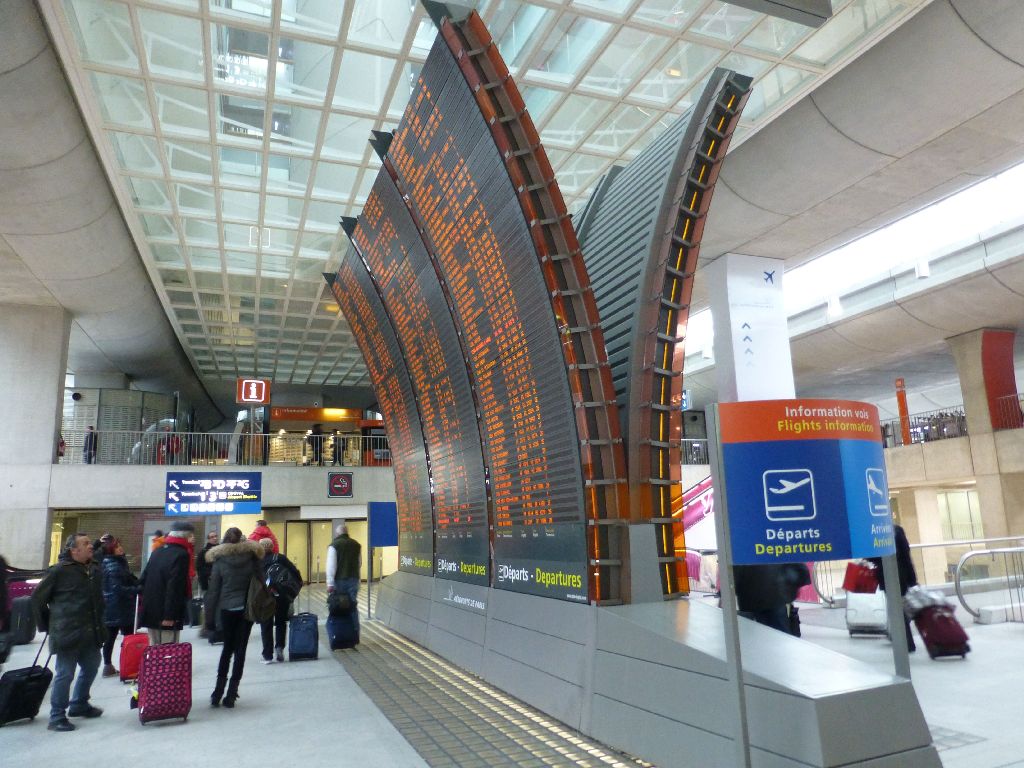
The same, from above

No worry: Flight MU554 is confirmed as departing from Terminal 2E.

This was the first time I saw automatic tax refund machines, used here by an Asian crew.
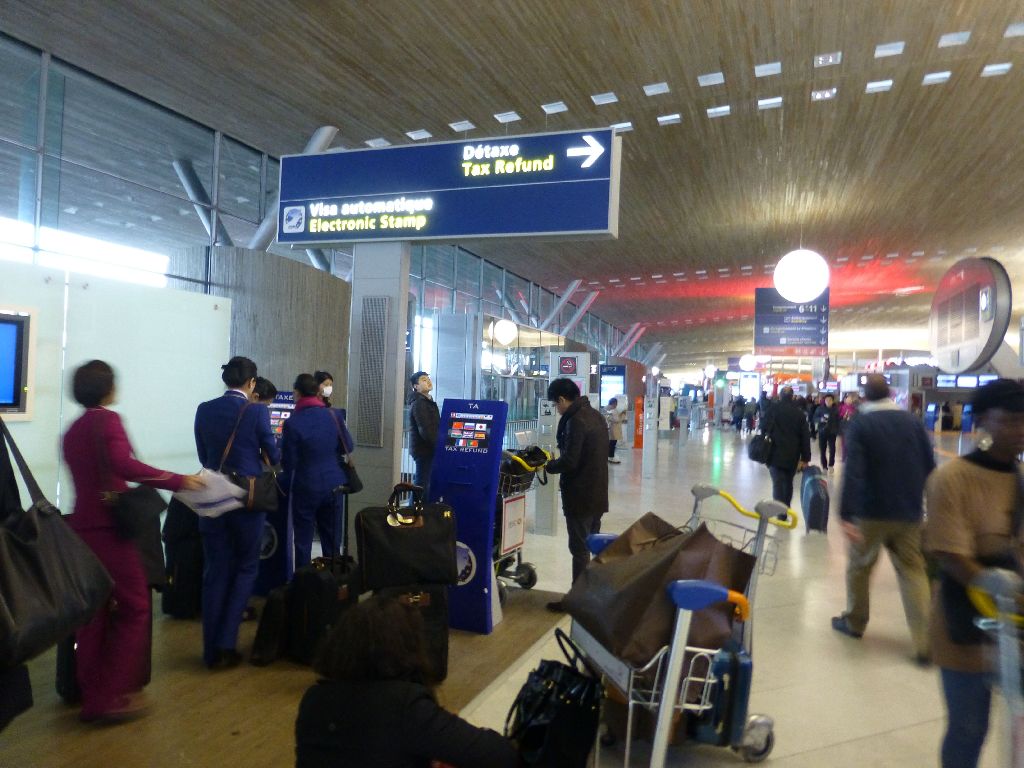
Check in for economy passengers is here,
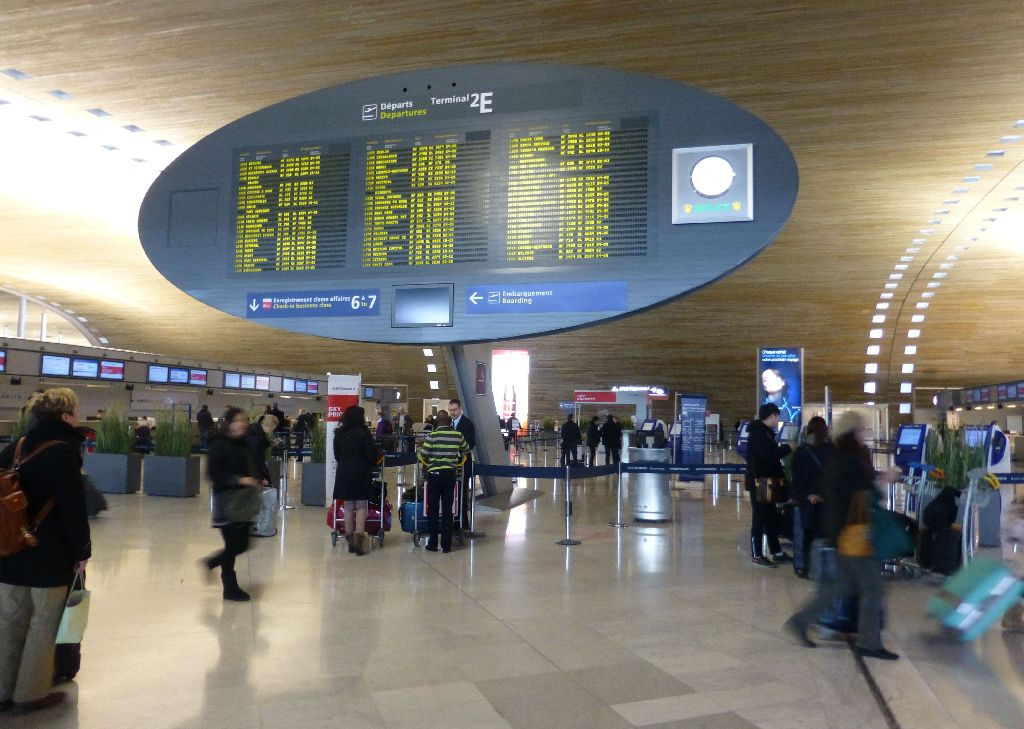
… but I was on final in a kiss landing from FB Platinum level to FB Ivory, one month from touchdown, and I still had access to the Elite / J / F check in counters.
Back in Taipei, I found the membership card of this exclusive club from which I had been excluded for five years. Platinum, gold and silver are mined in hundreds or thousands of tons per year worldwide, but ivory is such a rare commodity that hunting for it or exporting it is banned. At long last, I was making it !

Anyway, the action was behind this sign …

… and this was an umpteenth humiliating failure at the automated BP dispenser test.
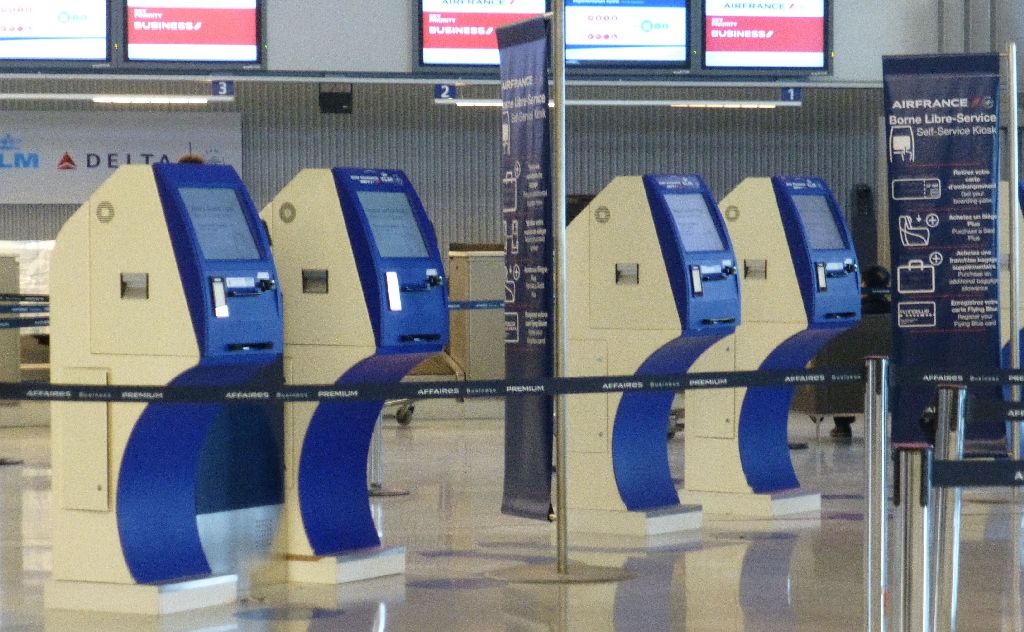
This time, the machine did recognize my identity, and requests my flight number. Typing two letters is obviously too complex for illiterate F/J/Elite PAX, so I had first to select the logo of the airline.
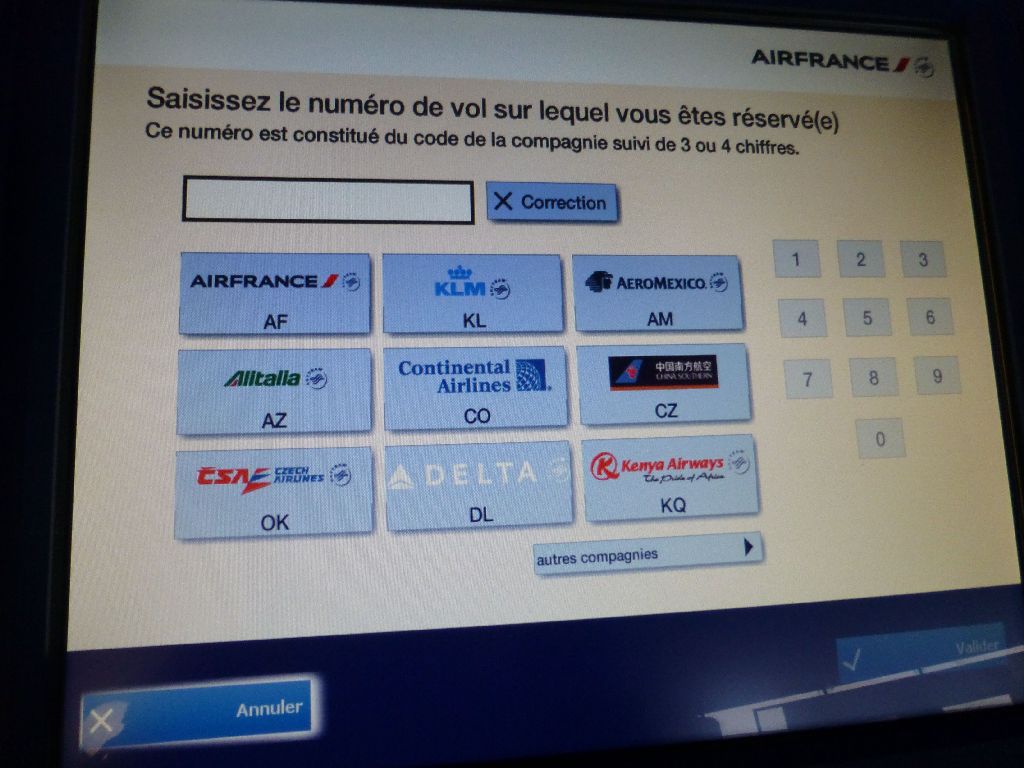
… lo and behold, the machine did not know that MU was part of Skyteam : no trace of China Eastern in all four consecutive menus. That appeared to be routine, and the staff made no problem to usher me in the old fashioned manual check in area.

- I have a passenger on flight MU554 to Shanghai; he has a French passport with an address in China; can I check him in all the way to Taipei?
I really wondered about the relevance of my address at the time when my passport was renewed several years before that flight, but it appeared not to be an obstacle, and I received both BPs. A good point for CDG; this had been impossible on the way in from TPE. True enough, the journey had been on two different airlines (CA and AF), belonging to two different alliances and operating in two different terminals in PEK with a dubious airside communication.
It's a (slightly) wrong world, and I had had to lug my maximized checked and carry on luggage to my Chinese friend's home that I met in PEK on the way in, whereas this time, I only had a carry on luggage with me.
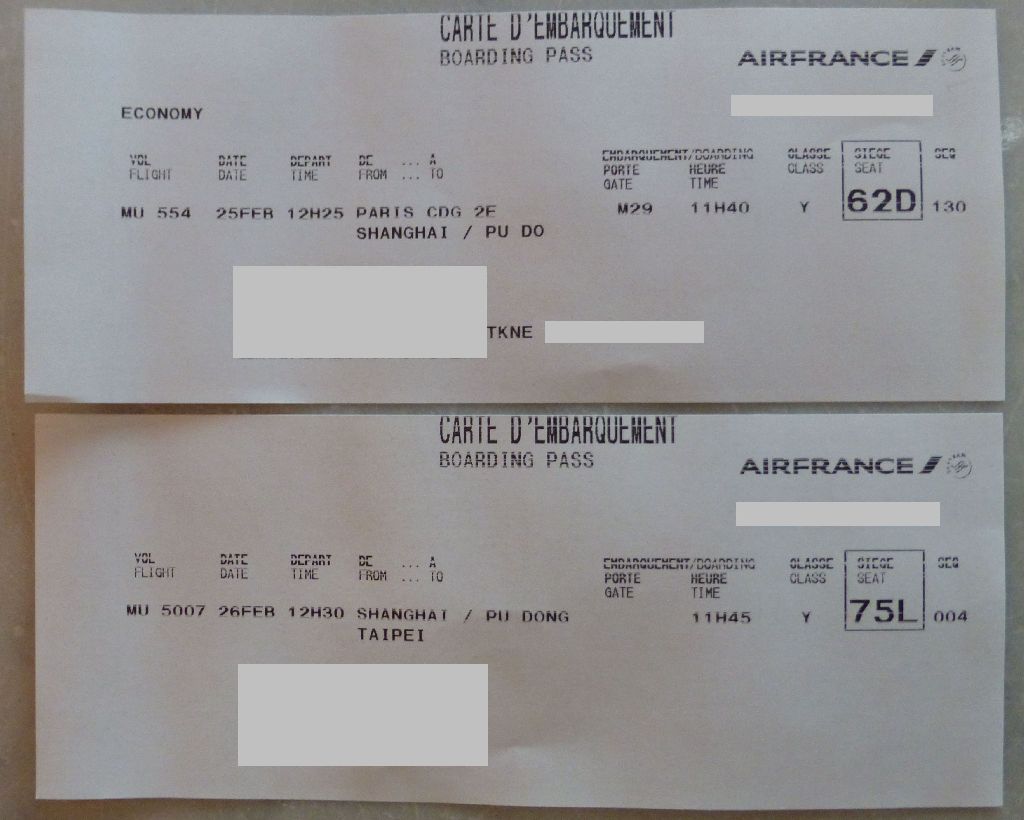
Only when I had received my BPs did I remember to ask for window seat. You're lucky, you do have a window seat: I took the check-in staff answer for granted, and only out of the check in area did I realize that if seat 75L had a good chance of being a window seat in the 346 supposed to operate the PVG-TPE flight, there was no way seat 63D ex-CDG could be one. It was nearly too late to have it changed: I had to go to the customer support counter, which appeared to support customers with serious problems: the waiting line was making no progress.
Was it really a problem? This flight was going to be mostly by night, the cloud ceiling was very low in CDG and there is not much noteworthy to see in the descent to PVG, where the weather is often very hazy. In short, there would be little to see outside, and an aisle seat would allow me to move around at will during the flight.

I had tried to check in on the internet, but MU's website did not allow it. In retrospect, I should have tried on AF's website, since this flight was codeshared, if AF accepted my e-ticket number, that is.
Going through the automated passport and fingerprint check gates, and then the people mover to Satellite S4.

An AF 777-200ER for starters of the ensuing plane spotting activity.
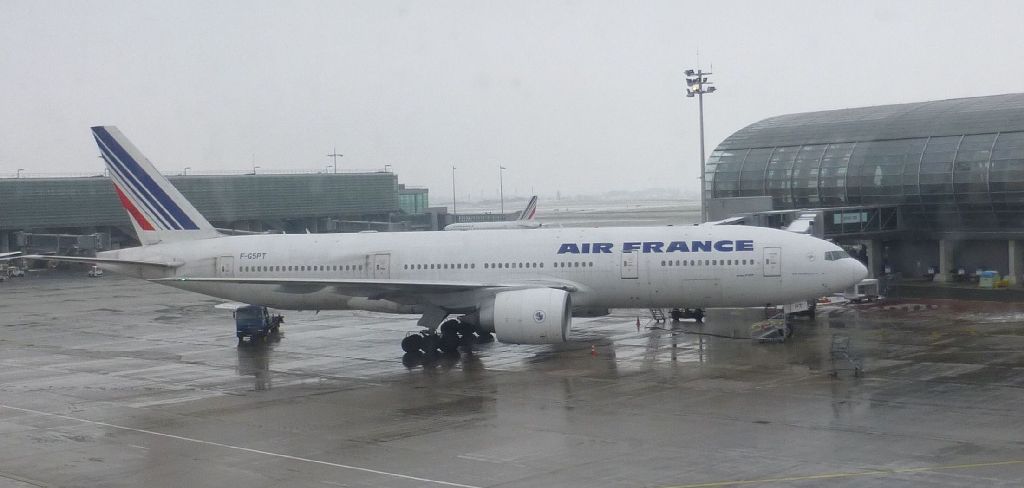
The security check was the way it should always be: a minimal waiting time, staff who was courteous staff, well groomed, smiling and efficient, poking friendly jokes to each other (I already told you that it is Hello, not Hallo).
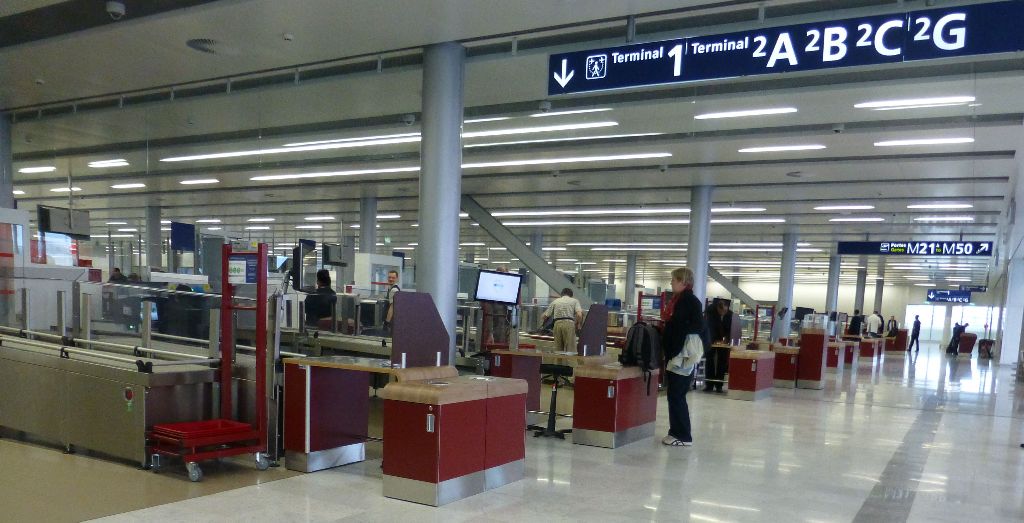
All this meant that I was quickly and agreeably airside.
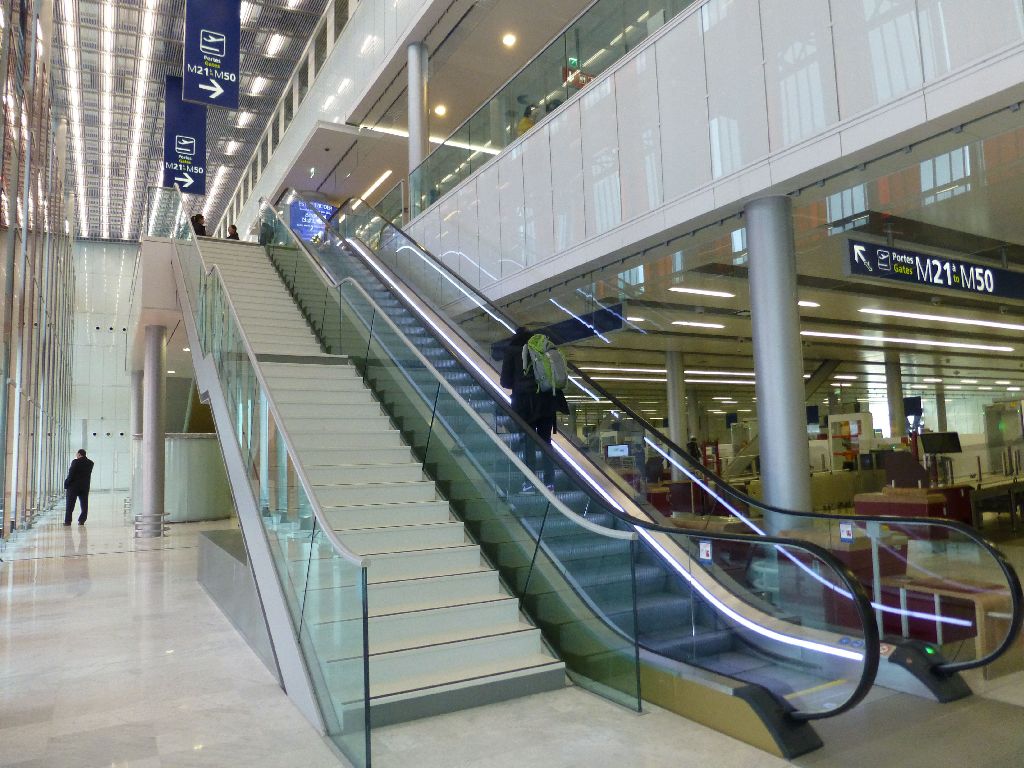
And after going through uninteresting shops
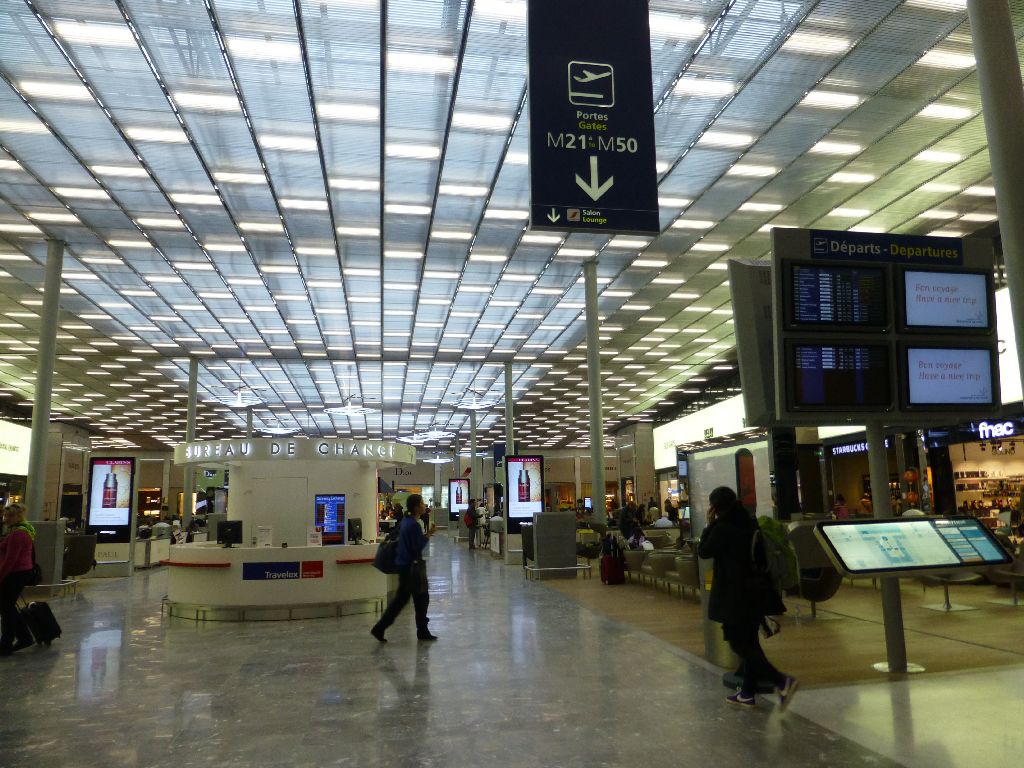
I reached the boarding gates which were completely empty when I landed on the way in
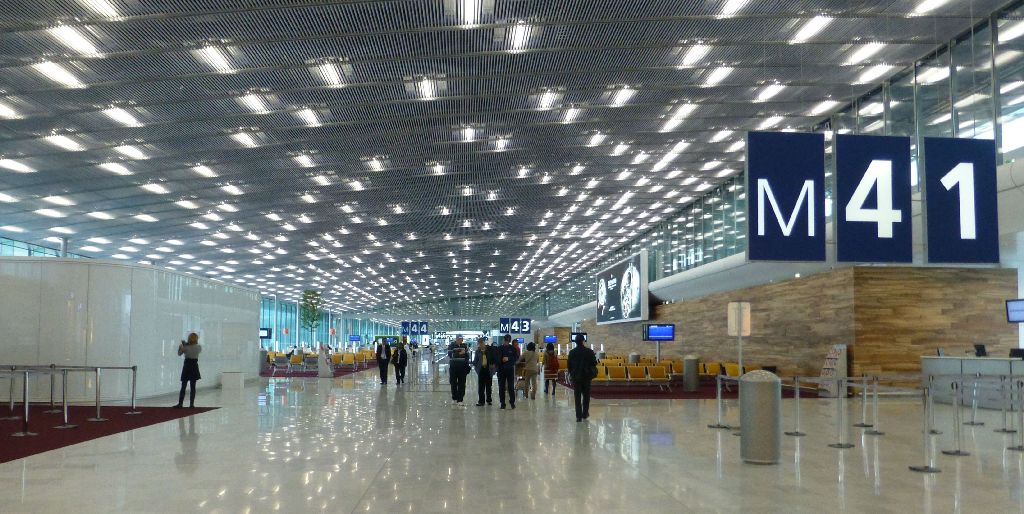
Even on a very overcast day, it was very bright and wide
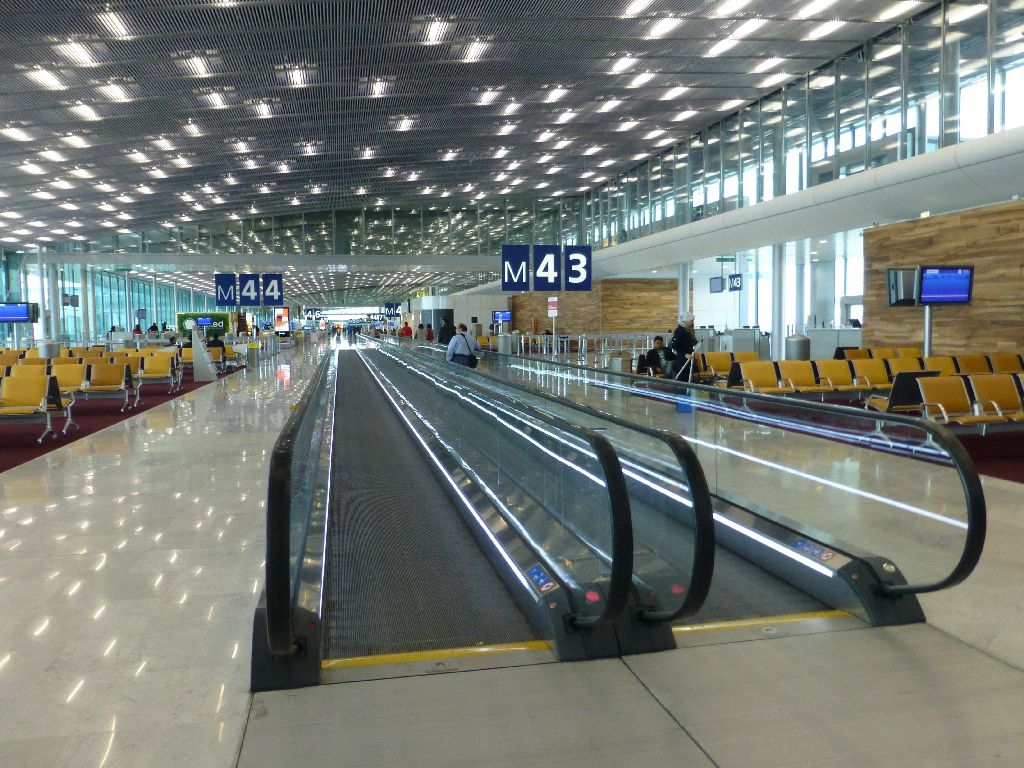
Some plane spotting; I'll spare you all the unescapable duplicates when you are at a Skyteam long haul terminal. Sorry for the reflections; the very dark weather did not help producing works of art anyway.
B777 recto

And verso

There were also four engine Boeing
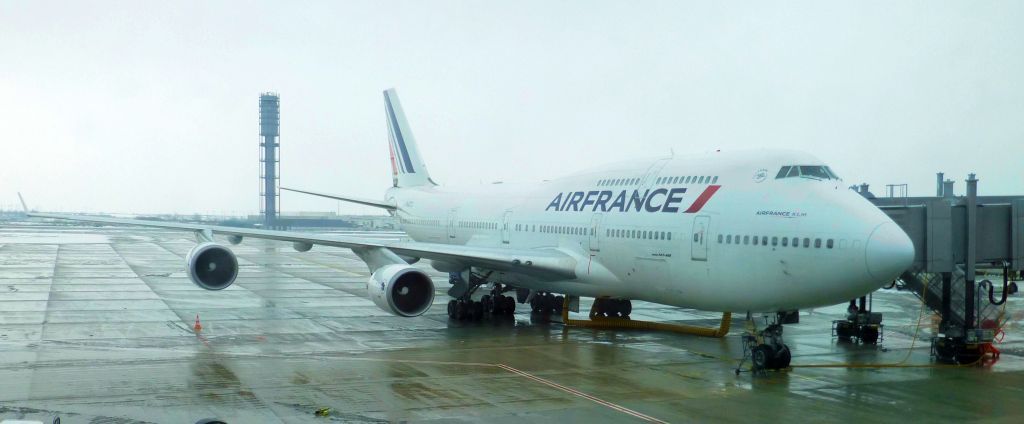
And Airbus, in a single deck version
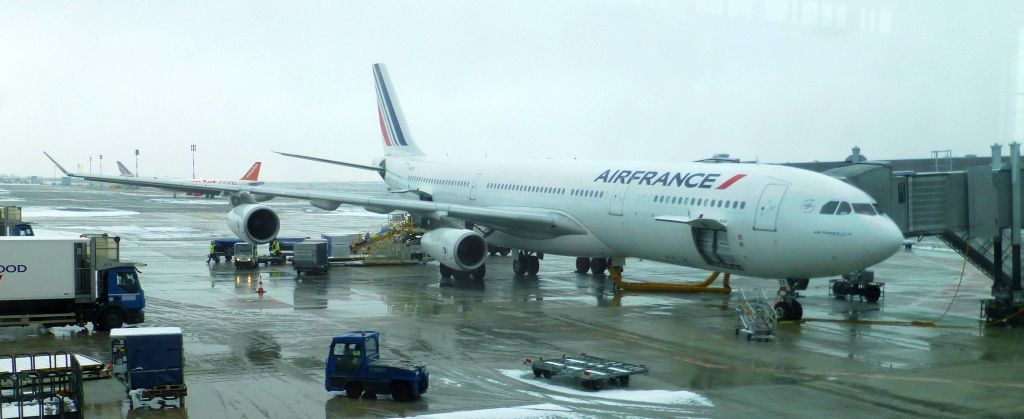
… and double decker

In case of emergency, there are obviously more people to evacuate on the main deck than on the upper deck, from the number of doors.


Smaller aircraft pass by too

Don't look back, I think we're being followed…
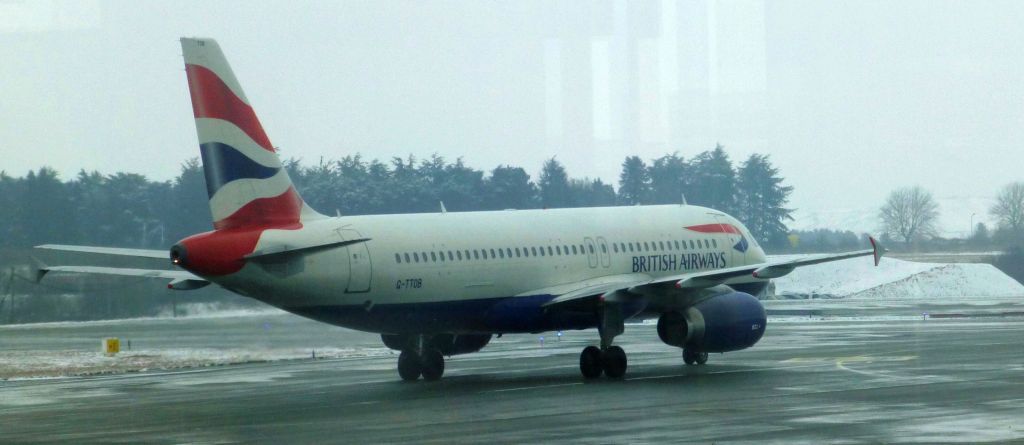
The tailing of that BA A320 was less than discreet

Two Easyjet A319 were also going to pass by there.
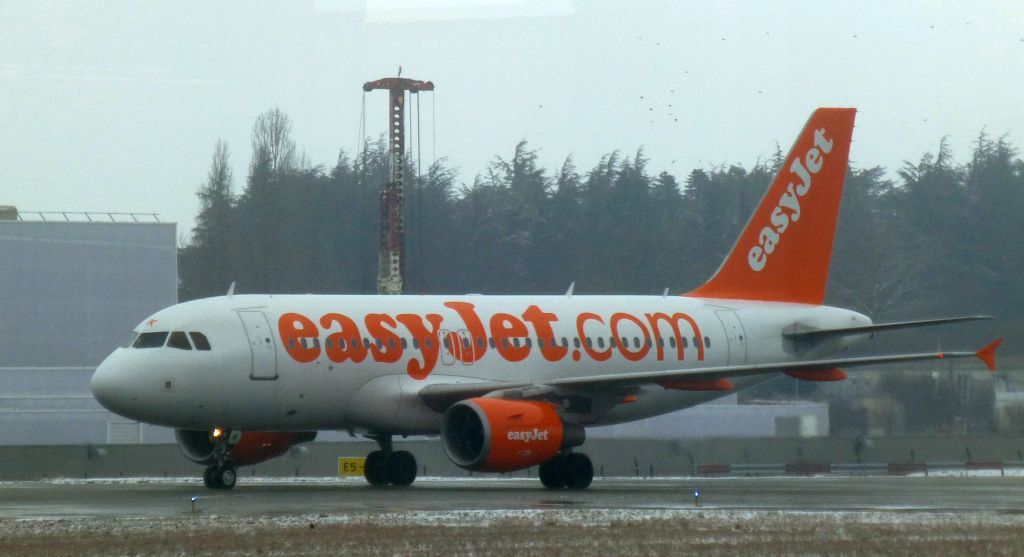
Our Community Manager was not in this aircraft
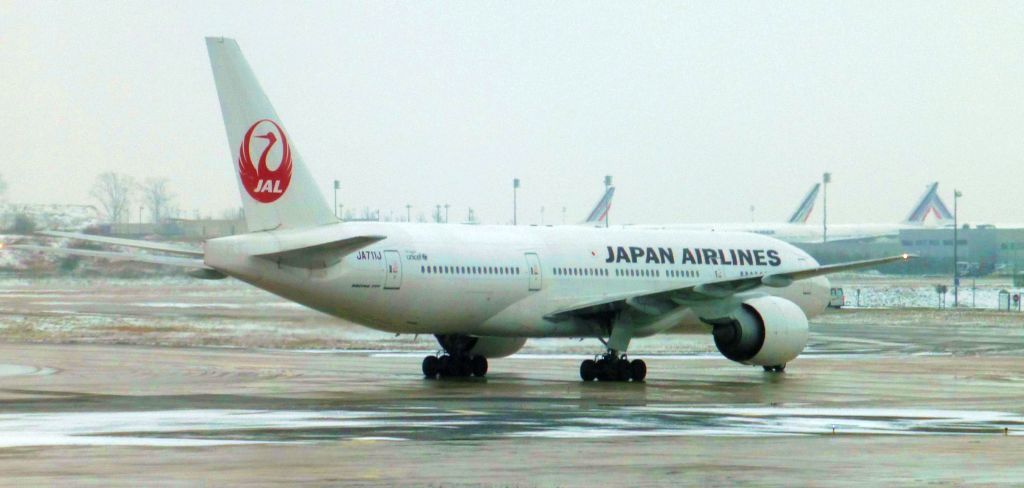
Last call for the flight to Minneapolis

… before pushback

AZ A321 further away

I guessed that this VN aircraft spent the night away from the terminal, before being pushed to the gate.

Now that I had exhausted the local Skyteam resources, two aircraft from the Balkan, with a Bulgarian E-190
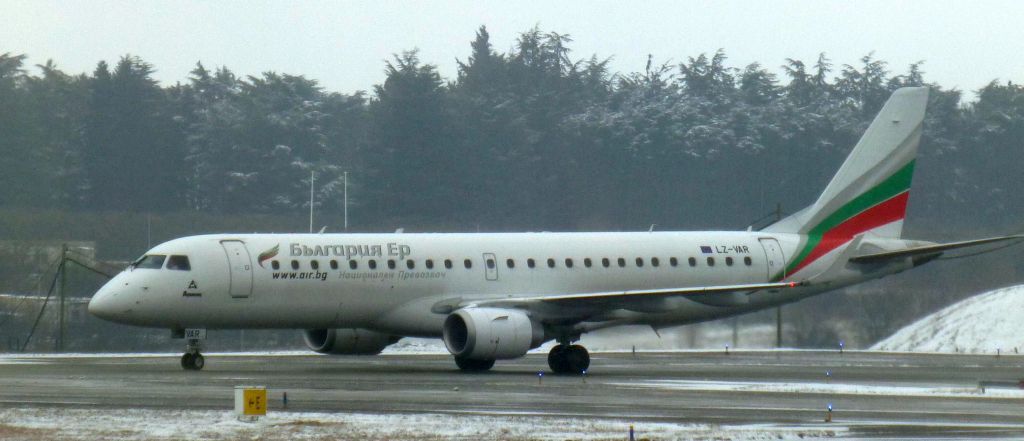
And its Serbian neighbor
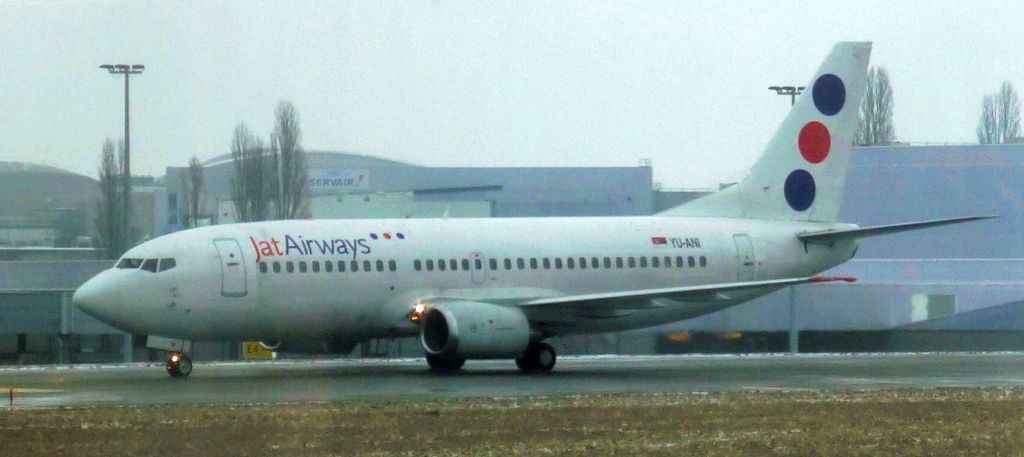
Now, one of my favorite pastimes. Not changing babies, but observing who is supposed to do it. No matter where you are in CDG-2F, changing a baby's nappies is a strictly female task.

But at the end of the terminal, beyond a small open garden which is supposed to be a smoking area (the smokers stayed in the access sas, because the temperature was at freezing level)…
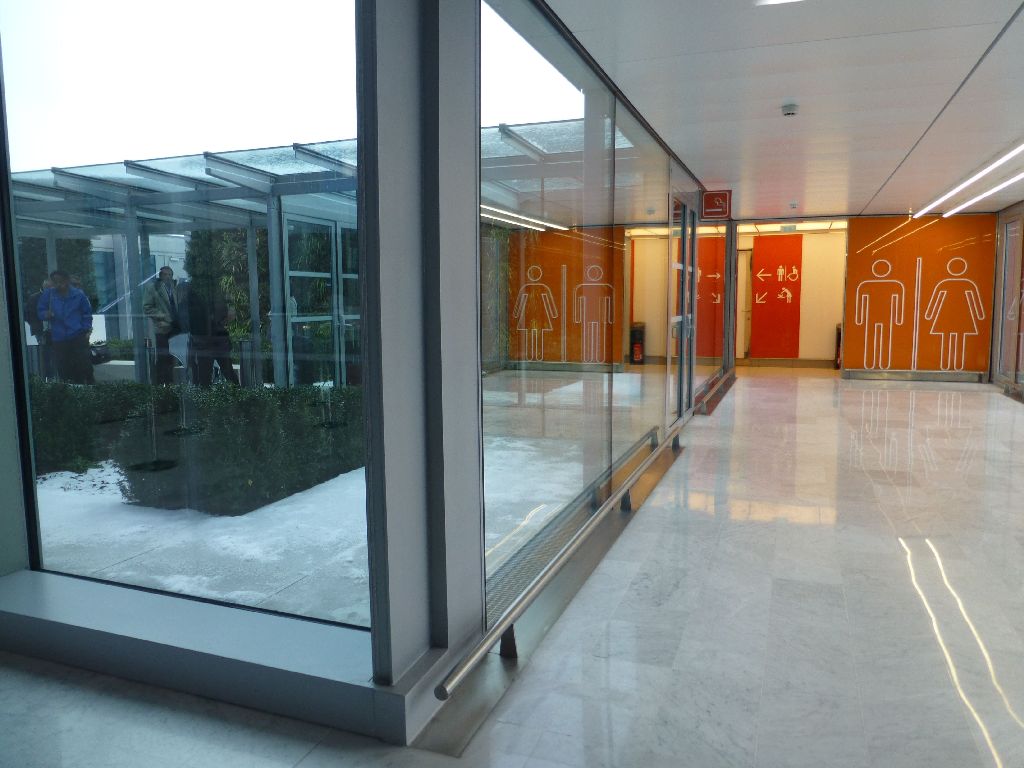
… the baby care room was directly accessible, immediately to the left of these pictograms.
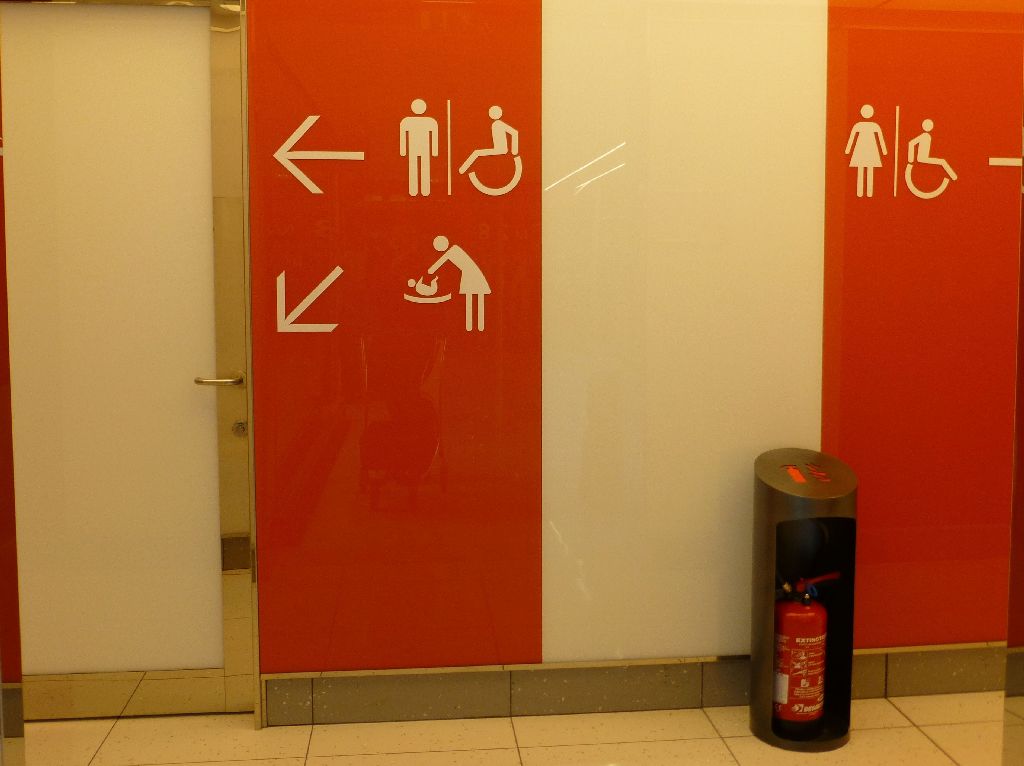
Terminal 2F's toilets? Spot clean, with decent aesthetics.

How do you recognize that there is a flight departing towards China? The dustbin of each toilet was full (but not overflowing ) of used toilet paper, because the Chinese and the Taiwanese usually do not thorw it in the toilet, but in the waste paper bin, to avoid clogging their plumbing. There was a bilingual reminder about that in the toilets of my office in Taipei. No, I did not take pictures, just believe me.
FR taught me that if you look for it, you can eventually find this tiny information at the bottom of a page of ADP's (Paris Airport Authority) website.

It provided me the de rigueur corporate screenshot.

… without hampering my laptop's autonomy, because unlike the Terminal 2F, devoted to Schengen area flights, there is a Type E/F electric plug every two seats, which means that you do not not need to fight for the use of the limited power made available to passengers. You sometimes feel in a third world country in some major airports. On the hand, a meager fifteen minutes free wifi allowance does look like CDG is in a very developed country.

HKG is not the only airport where you can have a short sleep while waiting for your plane.
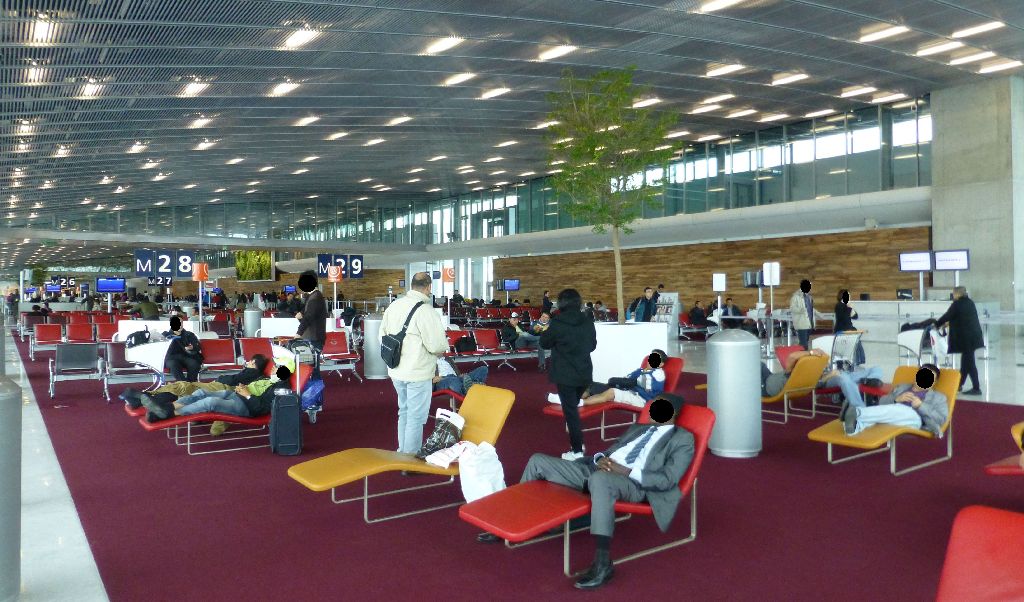
The seats underneath the mural vegetation decoration

There was a video lounge under a similar decoration, that I did not explore.
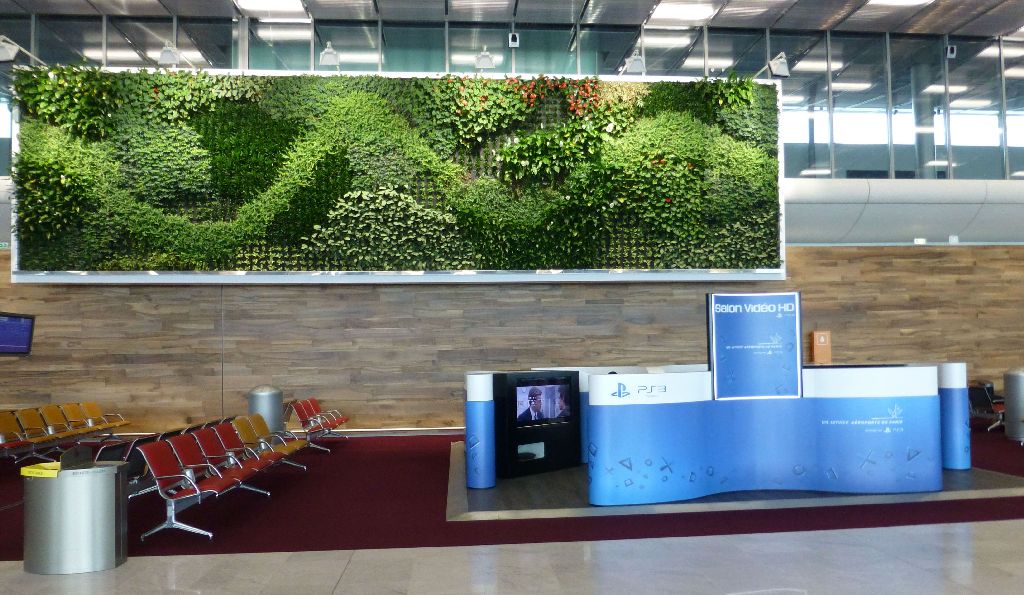
Ths narrow corridor looked strange when empty; it was meant to store carry-on luggage trolleys.
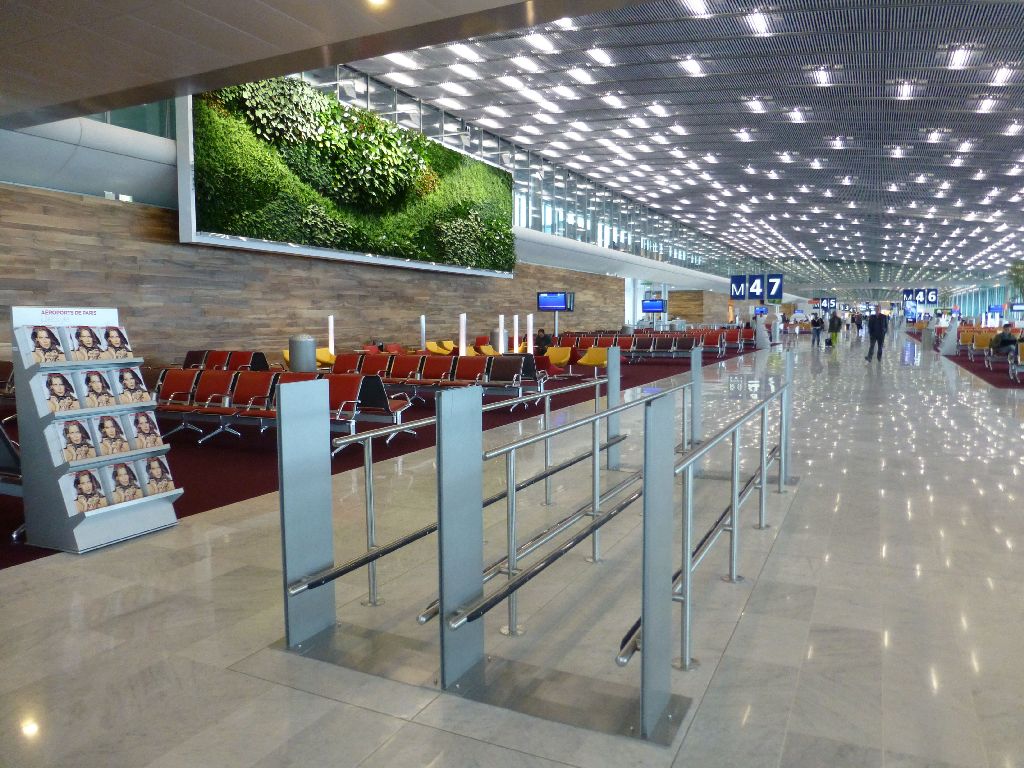

One of the two kids corners, for junior high students onwards in the foreground and primary school pupils in the background.

A lounge version

And mini-enclosures for listening to music

All this brought me to Gate M29 where there was not much activity half an hour from boarding time.

ADP was nevertheless optimistic in announcing that the flight would be on time. Note that in English, the destination is Shanghai Pu Dong, whereas it is simple Shanghai in Chinese.

Boarding was announced to be delayed to 12:05 due the late arrival of the aircraft, in flawless Mandarin and in French. This was the aircraft:

I exchanged a few words with a plane spotter, a student leaving to XIY (Xi'an). You don't make chance Flight Report encounters each time, and FR did not ring a bell to him, nor was he interested.
China Eastern appeared to have the same standards as Air France when it comes to aircraft exterior cleanliness. I take little risk in confirming that this was indeed an Airbus 330-200 as announced by the on line travel agency which had sold to me my ticket.
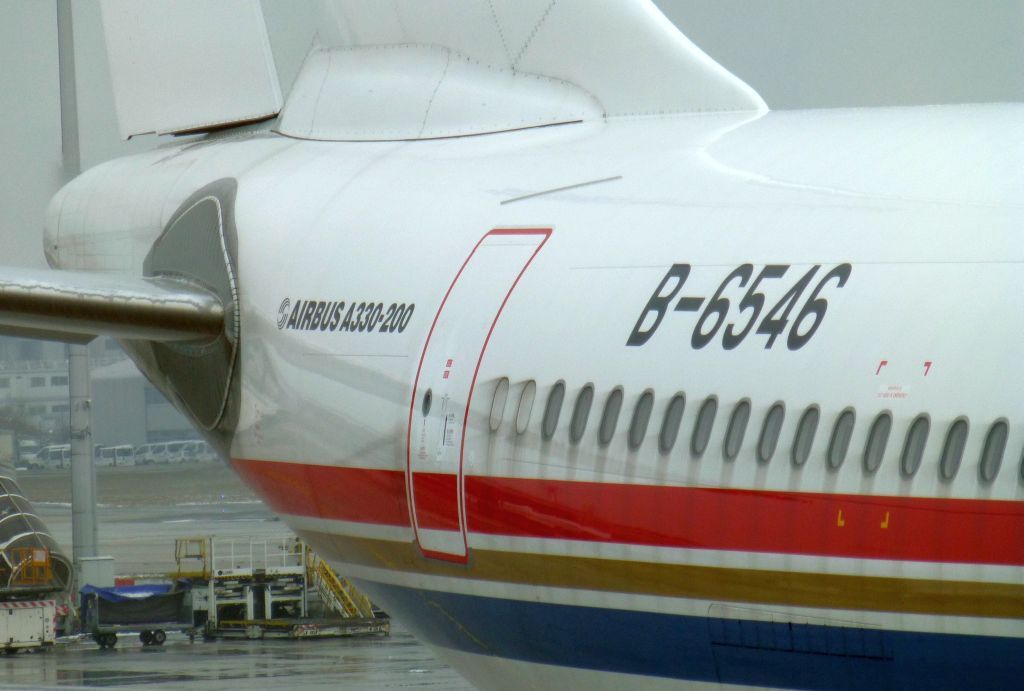
Tastes are personal matters, but I find that China Eastern's livery is very ordinary, and that the font used for their name is downright ugly, event though they chose traditional ideograms, those used only in Taiwan and Hong Kong in daily life. By the way, Chinese is always written from the front to the rear on the side of a vehicle, and therefore from right to left on the right hand side.
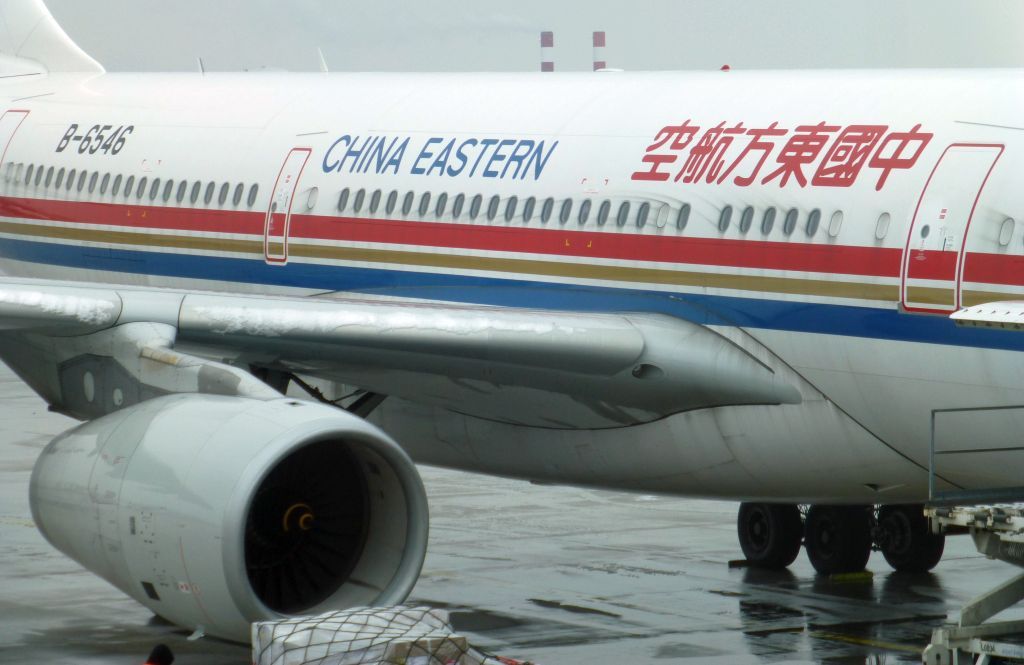
Boarding starts at last. Skypriority access is strictly respected, I only needed to show a sliver of my Silver FB card in my wallet to be accepted (the FB status was not mentioned on my BP). The staff did not check if my status was current.

A staff checked the BP and passport control in the jetbridge. There was no valid Chinese visa in my passport, hence this dialogue:
- Do you have a continuation flight BP?
- There it is.
- How long do you plan to stay in China?
- Look at this BP: the layover is only a few hours long!
- How long do you plan to stay in Taipei?
- I have a Taiwanese resident card.
It ended there, and gave me everything back. What surprised me was that this check duplicated the phone dialogue at check in… and that he did not ask me to show my Taiwanese resident card.
The newspapers are exclusively Chinese, but a rather shallow one is in English.

Note the two FAs welcoming the passengers outside the aircraft, and this mat which repeats it inside the aircraft, just after the door.

A glimpse at the J cabin when entering the plane

And the second Y cabin, still nearly empty. It is again a matter of taste, but I like the matching of the colors of the cabin, whether seen towards the rear

Or towards the front, with the blue of the welcome on the IFE matching the color of the seats.

For a long time, I hoped that the seats on my right would remain empty, but their occupants have been among the last to board the aircraft which turned out to be full in economy.
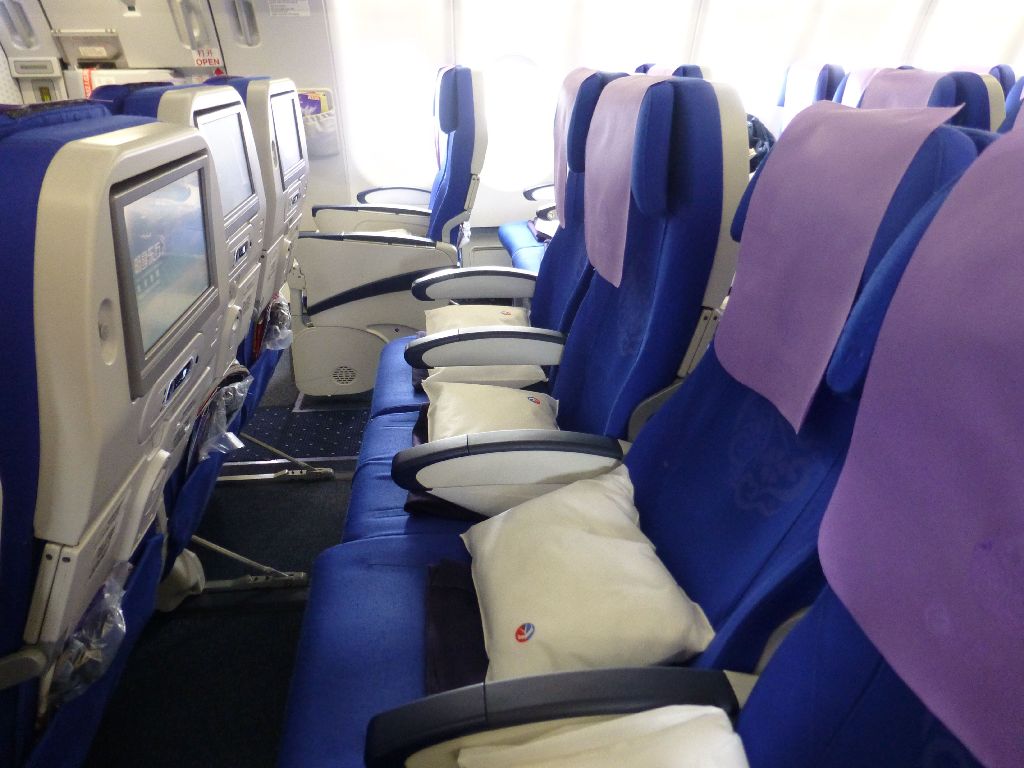
A close up on the headrest
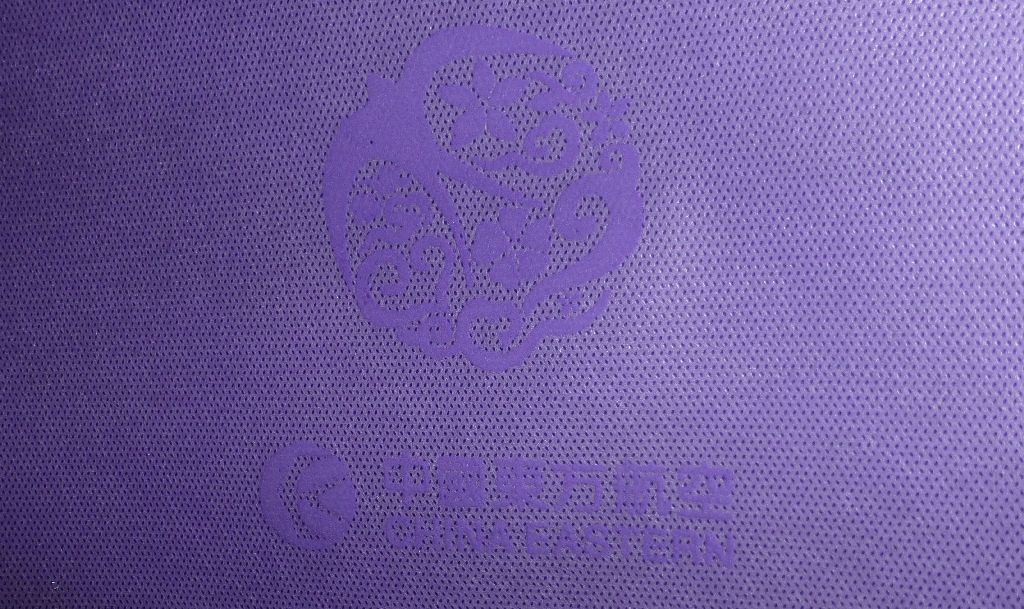
A FA explained PAX61K and PAX61L what they should do in case of emergency evacuation.
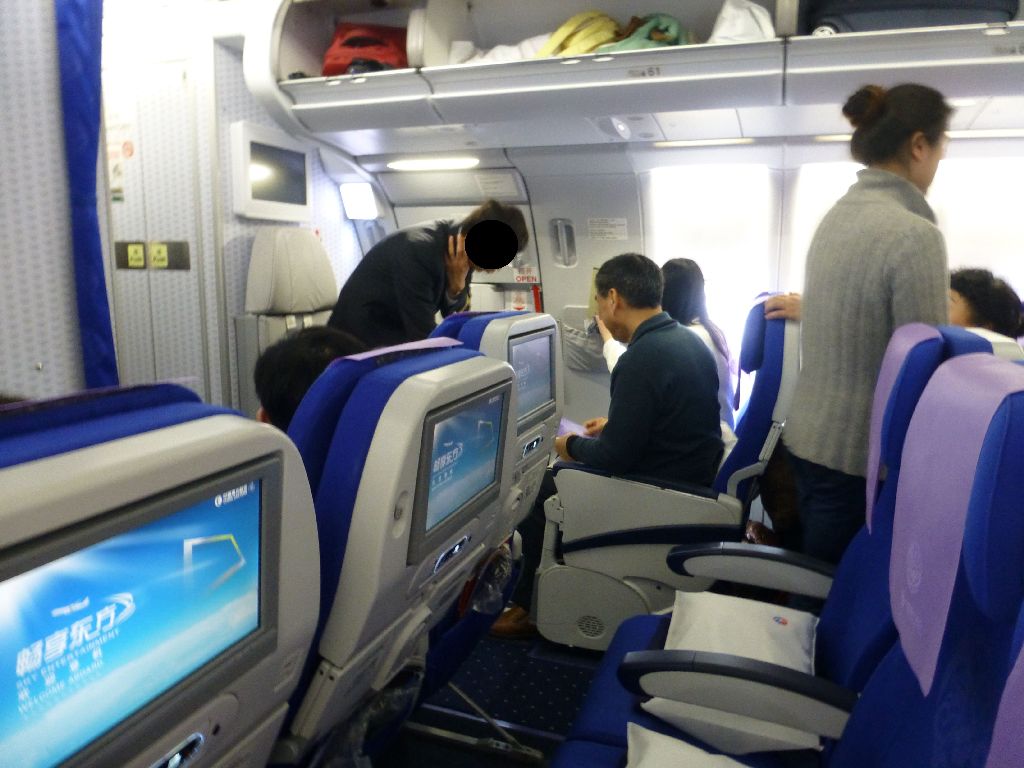
The weather in Paris made it predictable: the purser announced (in Mandarin and with efforts in English) that the captain had decided to have a shower for a 4,332.68 EUR fee (more, actually, because I only found the 2011-2012 season fares).
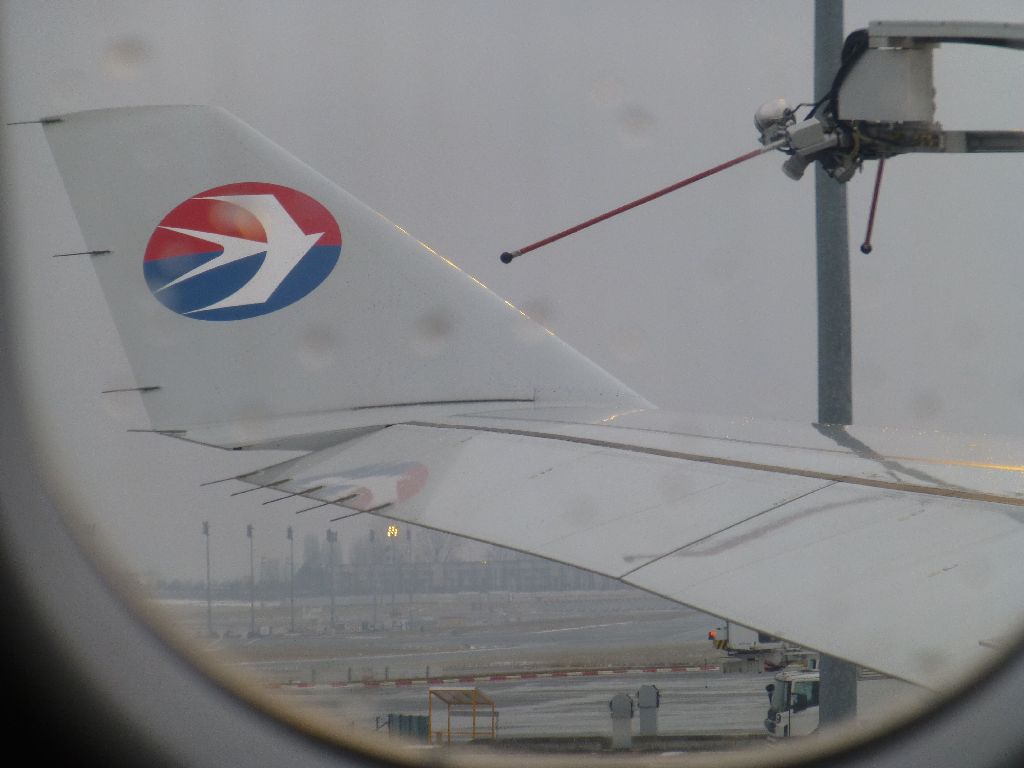

I had complained about de-icing messing up the windows when flying out of CDG a week before. The staff appeared to read FR, because they were careful this time not to spray their stuff on the windows.

Now let me introduce my neighbors. Some of you may not be familiar with MU's cabin arrangement, especially since like other Chinese airlines, they number economy seats from 30 onwards, so I thank seatguru.com for providing me this sketch.
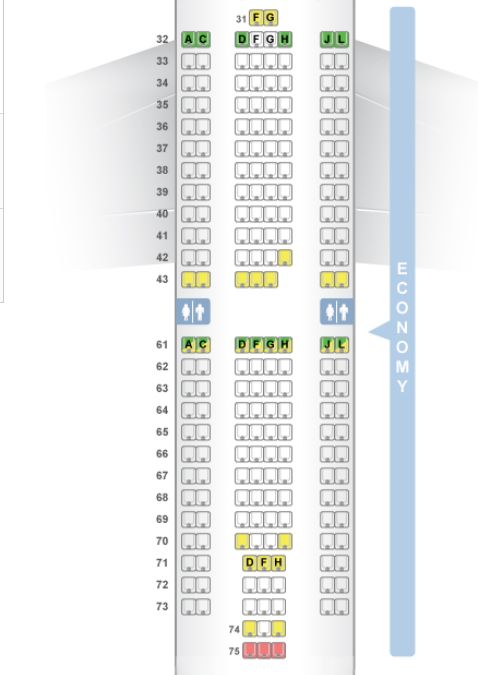
There were fewer than 10% French passengers on board (small wonder : everybody including myself was going home after the Chinese New Year holiday), and many were obvisou Chinese - French couples. It was the case of Mrs PAX62F and Mr PAX62G, in their forties. Mrs PAX62F helped Mrs PAX62E use her IFE, and I to plug her earphones.
Mrs PAX62EE was a charming grey haired Chinese lady, travelling with Mrs PAX64A and Mr PAX64B, a Chinese couple who were obviously his daughter and son in law, or his son and daughter in law. Their mother language was not Mandarin used by Mrs PAX62F, but they of course understood it.
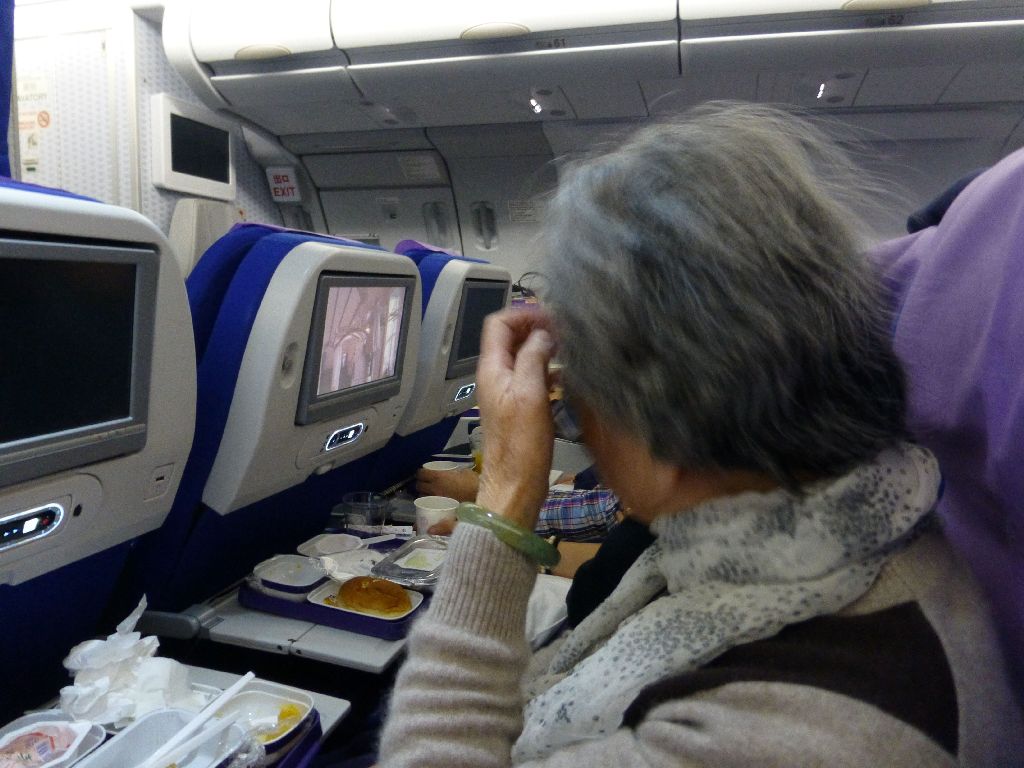
Mrs PAX62E was quintessentially discrete, and only left her seat twice, when I left mine. I did not want to disturb her and did not use my too bright reading light when I was typing my FR while the cabin was darkened. I keep a grudge against KE FAs who mandated that I work in the dark on a daylight ICN-CDG flight in J, but the comfort of Chinese elderly lady was a different issue to me… maybe because the former were young enough to be my daughters and the latter old enough to be my mother.
And then, in the row before me, there were Mrs PAX61E and Mr PAX 61G, who were not seated next to each other because they travelled with PAX61D, PAX61Ebis and PAX61F. You probably guessed that PAX61Ebis was slightly below two years old: she was very cute, but the delayed take off had not been expected, and a FA allowed Mrs PAX61E to take her to the toilets while the plane was being de-iced.
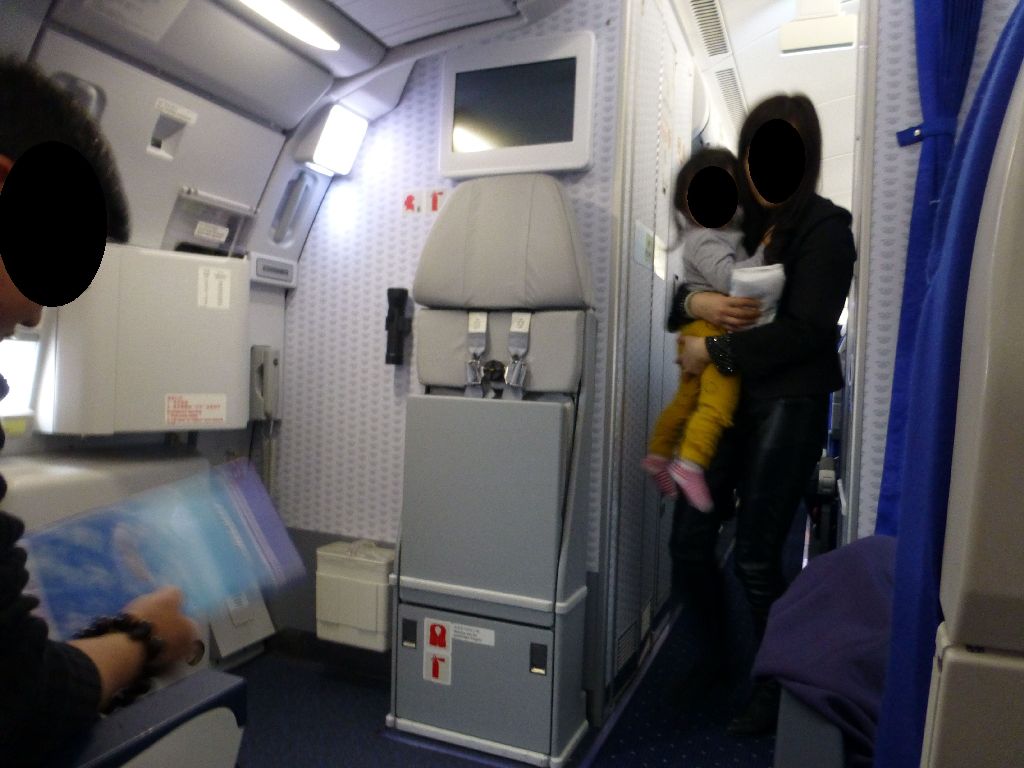
This did not bother anybody on board, but young PAX61Ebis, along with her older sister and brother did not quite understand the basics of time zones and jet lag. I could not accuse them of being poorly educated or turbulent, but they did chat and play until it was time for bed for them in French time, i.e. in the vicinity of Mongolia. PAX61Ebis was actually getting quite tired and cried for a long time, because getting asleep in her mother's lap was not easy. Another Chinese couple came to chat with them after breakfast - obviously kin.
I tried in vain to imagine Leadership on a night flight behind these kids. Actually, it was just as difficult to think of him buying a ticket in economy on MU, or me buying a ticket in first class on EK ;)
I am size S, which means that I am compatible with the seat pitch of any legacy airline.
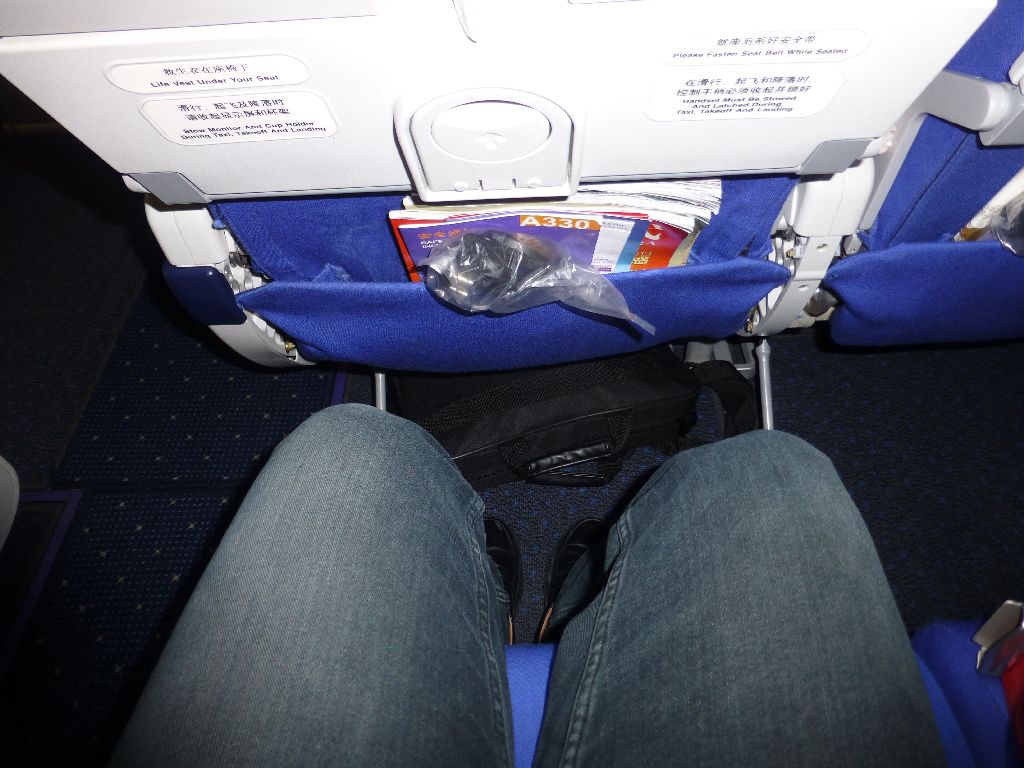
On the other hand, PAX62B, like me a Westerner travelling alone, was size XXL. He would not fit in any seat pitch in economy, and regularly extended his nearly two meter long body into the aisle.

How about the comfort of that seat? Well, I found it very decent, for economy. I did not get the feel of it being narrow, even though it is listed as only 0.8 wider than AF's Boeing 777 seat which I had felt cramped in the other direction. Was it that it was an aisle seat versus a window seat? Maybe, but I had no need to stretch my legs in the aisle.
The safety demonstration was entirely on the IFE, repeated twice with a voice over in Mandarin, subtitled in Chinese, then in English subtitled in English, each time with a brief summary with sign language.


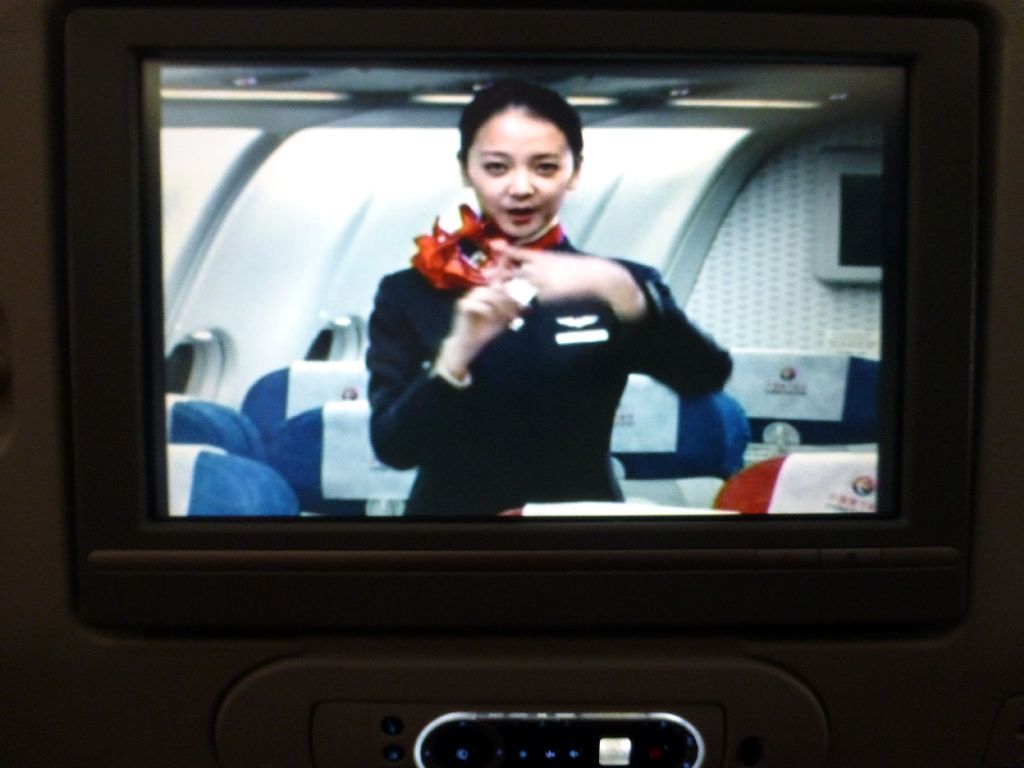
Being close to the emergency exit provided me a lot of visual space on the left, even though the seat layout was not different from that of aisle seat at other rows.

Another view from my seat

The mandatory (on board and in the FR) safety information card, printed on rather thick glossy paper.
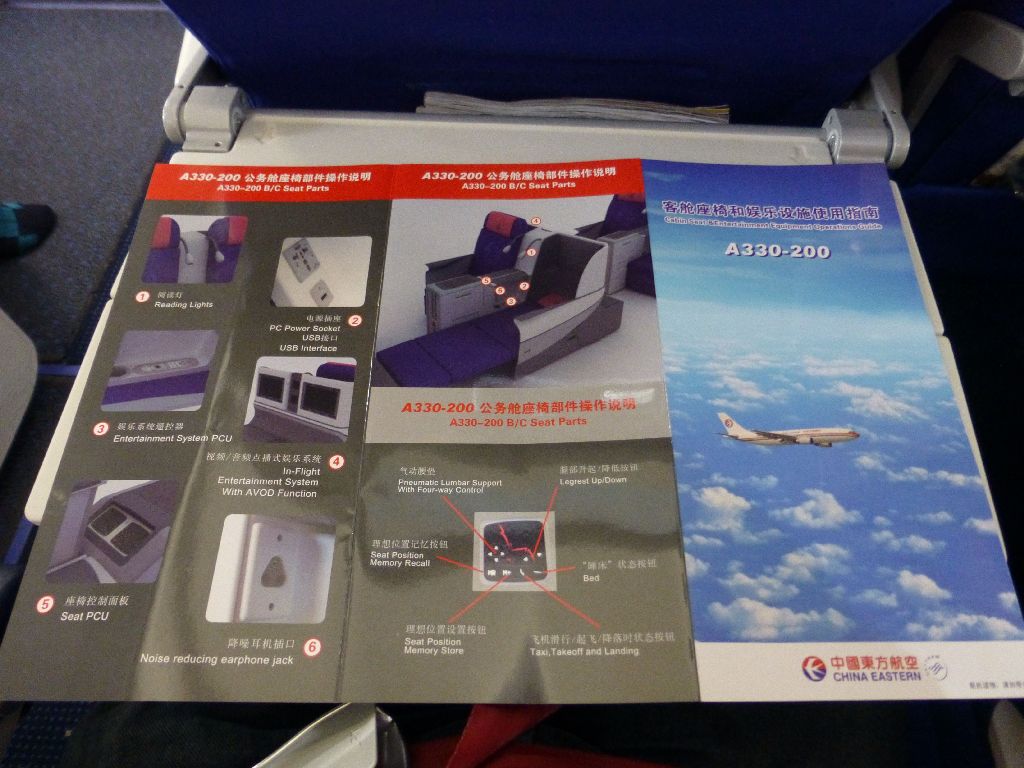
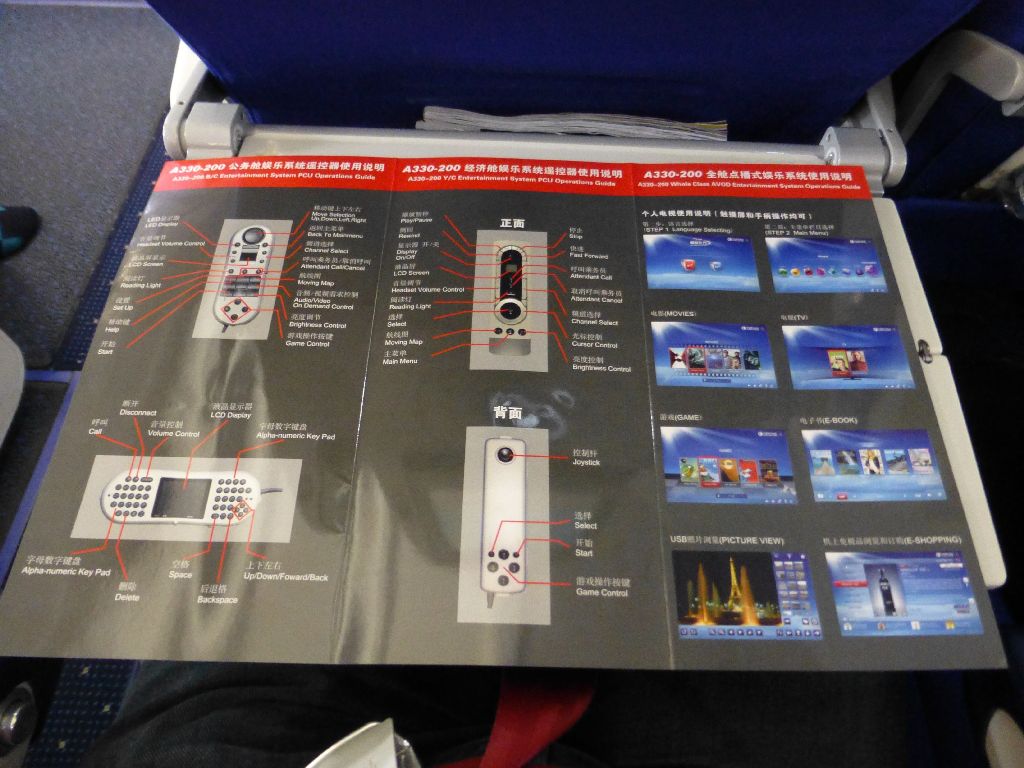
The FAs passed around to distribute glasses of water to the passengers: it must be standard MU practice, for there had been the same distribution during the lengthy pushback on my later PVG-TPE flight on MU.
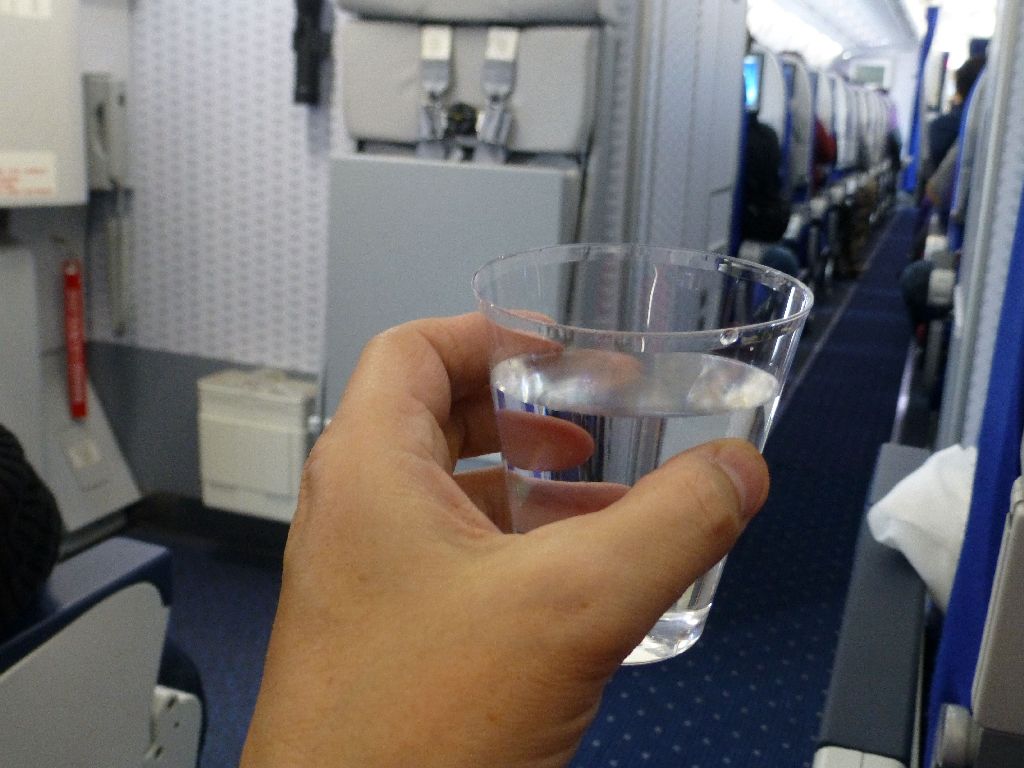
This provided me the opportunity to produce a typical Chinese counterfeint signature shot… without a window, without sun, without glass and without bubbles.
By the way, I dropped a cup on the floor: a FA dumped in the rubbish bag even though I was going to use it, since the inside could not have become dirty.
During take-off, this FA was chatting with the passenger facing her. She was definitely not beautiful, but she had a very friendly smile. I doubt her way of buckling her seat belt was really by the book.

I did not have a window seat, so I used the tiny window of that door to take a picture of the wing.
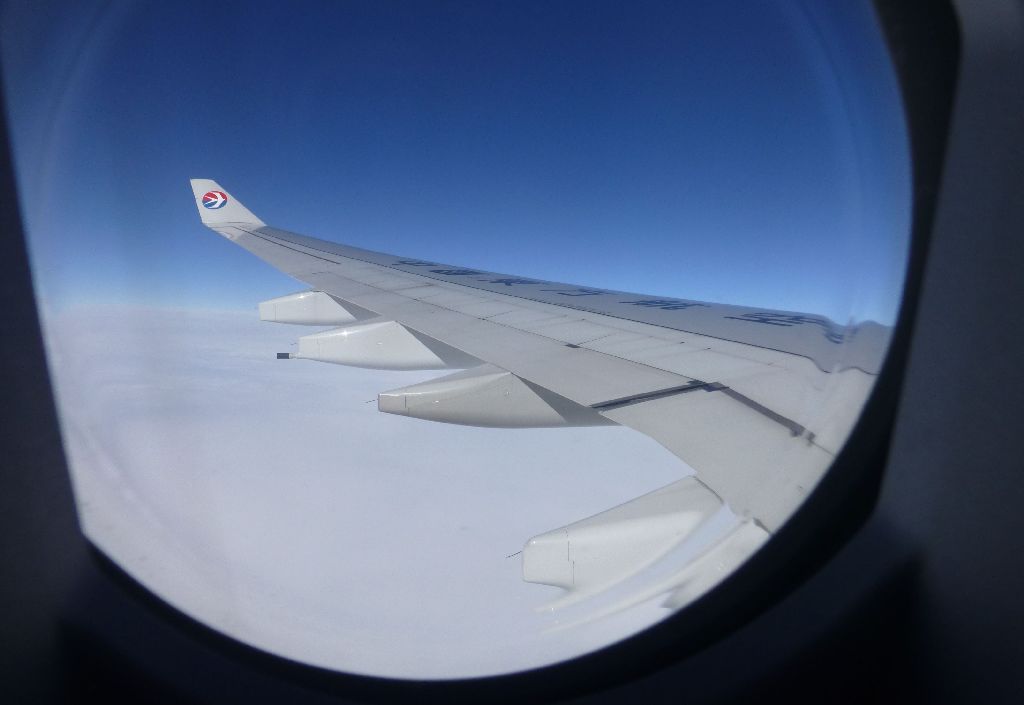
And the winglet

A first pass to propose a drink (apple juice for me, I saw a bottle of red wine) and distribute 20g peanut bags.
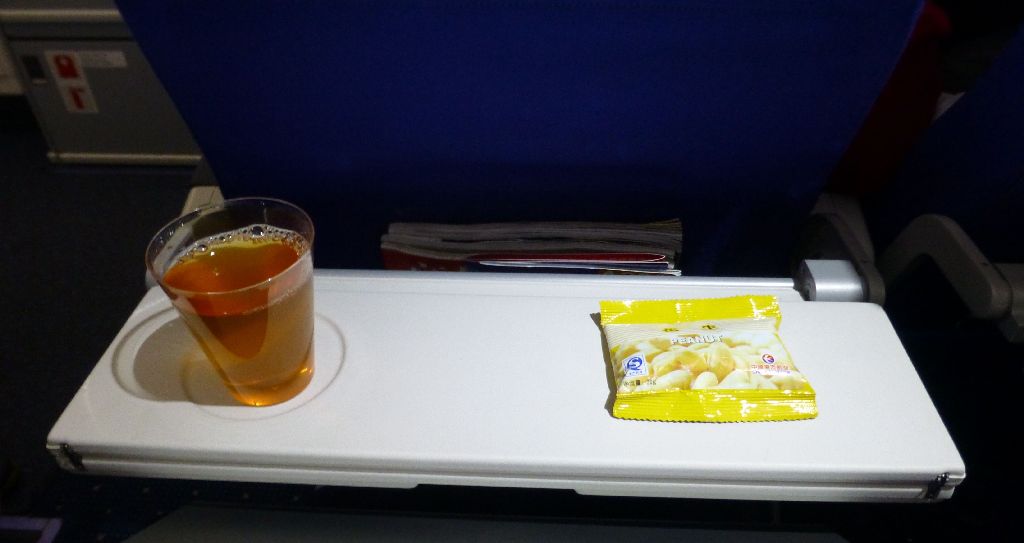
The meal was served slightly later
????? Nín yào shénme? It may seem curt, but this is how you say What do you want? in Mandarin, a very compact language at any politeless level. The efficiency of the Chinese FAs surfs on the fact that most passengers are Chinese, and are therefore used to the choice for the hot meal: it is chicken-rice or beef-noodles, like on domestic flights. The noodles are often overcooked, so I chose rice, therefore chicken.

The catering was loaded in Paris, but the meal met Chinese food standards, with a vegetable which is very common in China. Would you have notived these tiny portions of a red vegetable? Not tomato of course, but hot peppers, because food in most of China is very spicy. In France, it would probably be rated two peppers on a scale of three in an Asian restaurant. I liked it that way, but I know French people who would have been unable to eat that.
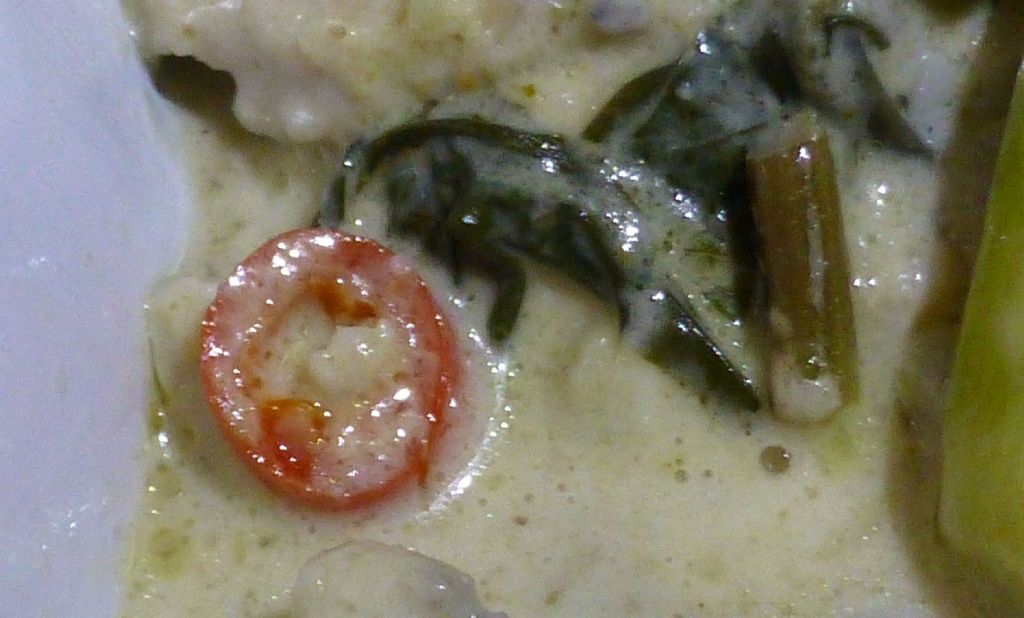
Coffee was average, not more.

A view of the cabin from the rear. At the beginning of the flight, a FA told me No photo! as I was in the symmetrical position. I was surprised – it never happened to me in Chinese aircraft, and not bothered, since I knew that I would have other opportunities to take such pictures later during the flight.
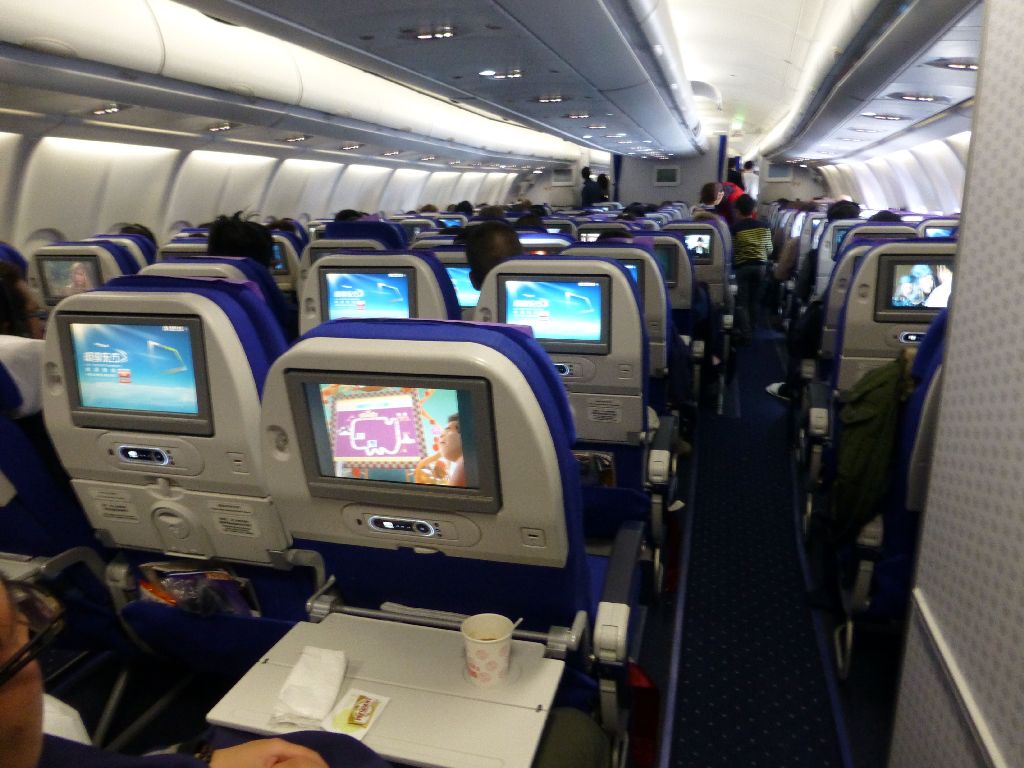
I waited for a long time at these toilets on the rear, together with a Chinese lady, until a FA came up, knocked on the door without receiving an answer, opened slightly the door without any reaction inside, and found that it was empty.
Meanwhile, a rather rowdy French-Chinese kid came and started to want to play with the controls of the door, only to be reprimanded successively at growing sound level in English by the Chinese lady, in French by me and in Chinese by a FA who sent him back to his mother with adequate curtness.
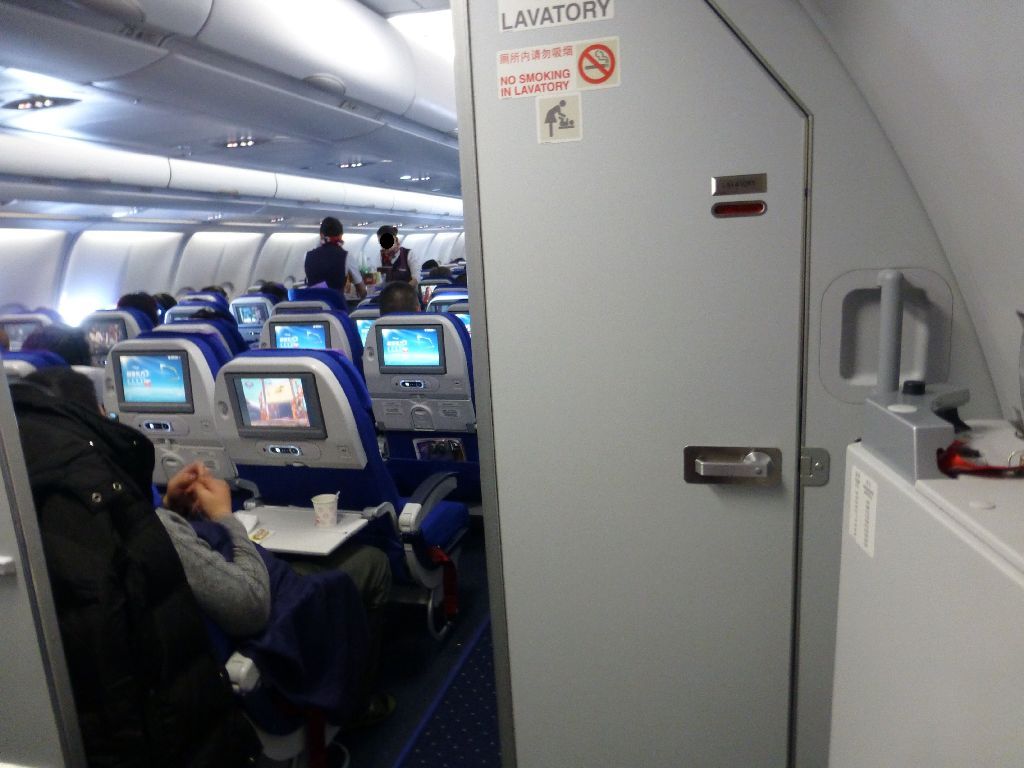
The toilets in the rear were definitely narrow, and it must take all the suppleness of a mother to change a baby's nappies. No wonder the pictogram states that this task is for women only.

There was slightly more space in the toilets in the middle of the aircraft

Why did a FA need to jury-rig this reminder, with a small error in of the ideograms? Maybe because (s)he hoped not to need to clean again after a passenger had disregarded the standard bilingual garbage indication in grey on the right.
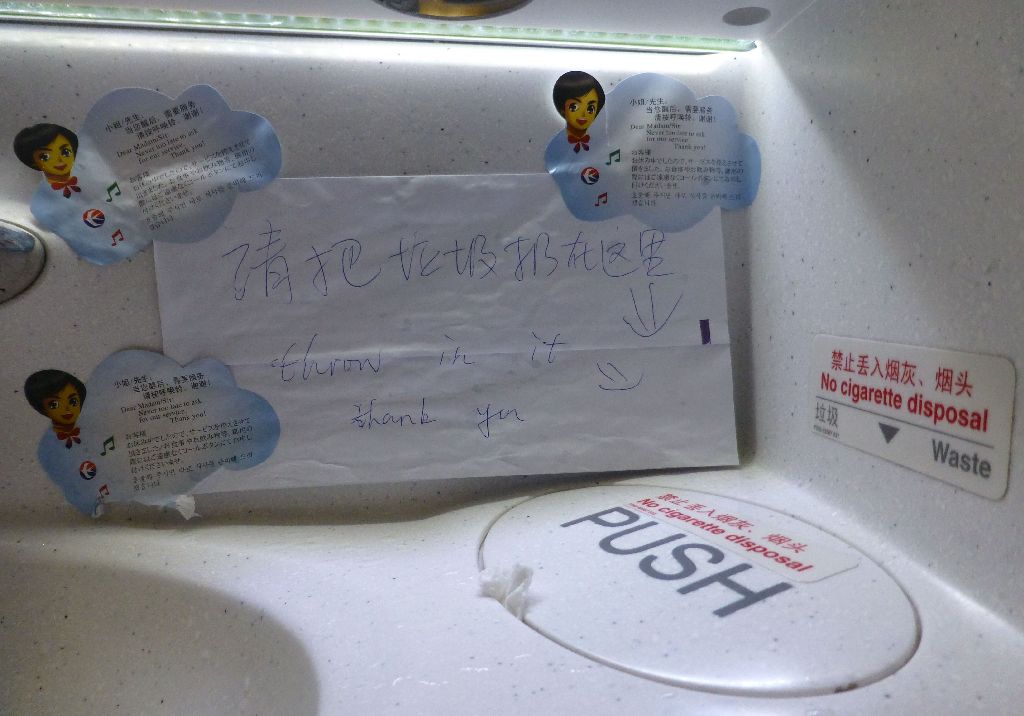
In replacement for missing rubber tape, (s)he used a sticker meant to be affixed to the seat of a passenger found sleeping during the meal service

The tiny differences in translation in the various languages amused me (sorry, I do not know Korean):
Chinese : Lady / Gentleman, if you wanted service after wake-up, please press the call button. Thanks !
Japanese : Dear passenger. Since you were asleep, we did not serve you. If you need anything, food, drink… do not hesitate to press the call button.
(the expression in Japanese is neutral, which avoids the Madam/Sir alternative)
Have you ever seen a similar sticker in your favorite airline ? (let's assume that it was meant to be used in J/F only).
Lights out in the cabin at 22:45 Chinese time, but it was a difficult night due to the above mentioned children.
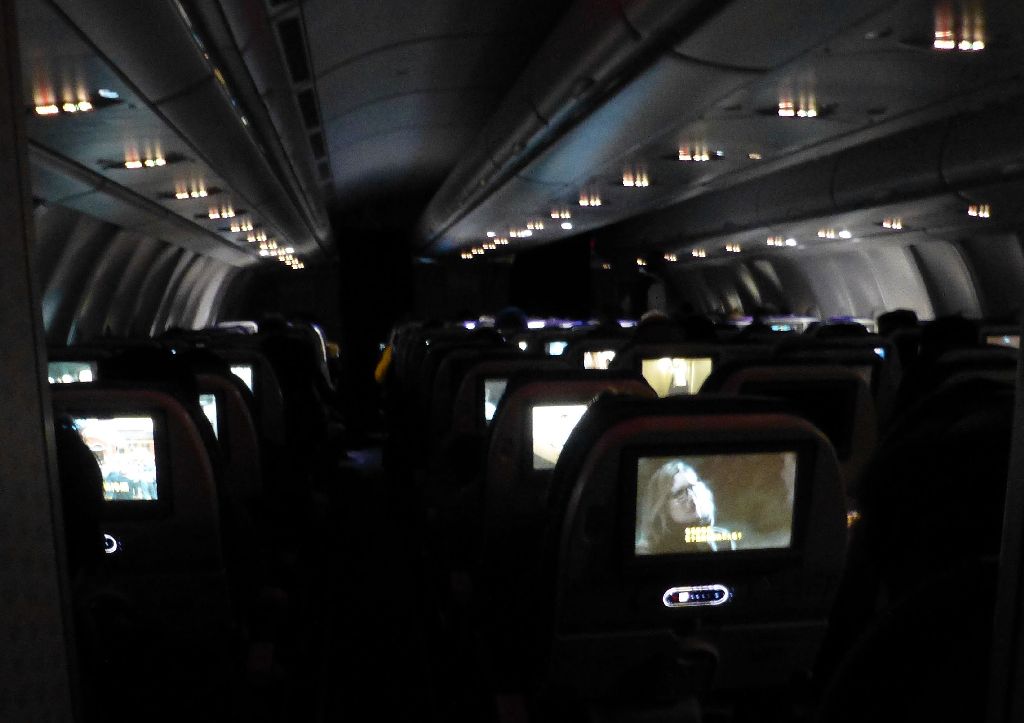
To spend time, I used the resources of the IFE, which I seldom do.


The first finding was that the screen was not very large, but the quality of the image was excellent.

It was adequate to comfortably watch a movie. I was not very convinced by the selection (around ten French movies, as I recall), but I am not a specialist in these matters.

In accordance to the destination, I spent time playing Shanghai, a classic puzzle game dating from the 80's. Funny that there is a clone called Taipei.

There was no AC power (this was economy, after all), but a USB plug recharged my camera battery, which saved me the shame of have a depleted battery when came dessert (insider joke).

During the night, the rear galley is already a tiny China. You like it or you don't, I love it. Have a dozen Chinese passengers relax and chat in a language that I did not identify, maybe Shanghainese ? A passenger came up to refill her vacuum flask (they all have one, since no self-respecting Chinese who drink cold water), another prepared a bowl of instant noodles, another basics of today's China.

There were some stodgy cheese and dry sausage sandwiches. A FA served me coffee, which was again nondescript. The FAs actually never stopped working, for they regularly passed in the aisles to propose water or tea, with a soft ?????Nín yào chá ma ? (Do you want tea ?), loud enough to be heard when you are dozing, but low enough not to wake you up.

The sample of cold beverages

There were also two coffee pots, on the top left, and the red hot water tap.
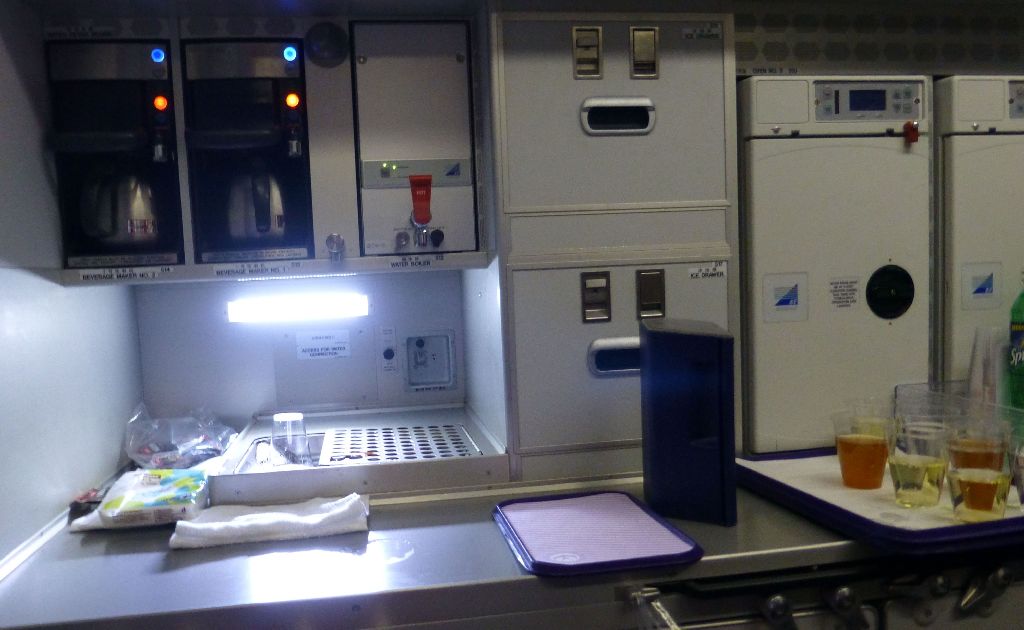
No choice was given for breakfast, served at ETA -2h30. Nothing very exciting, but it was decent for economy.

Each movie on the IFE started with ten seconds of advertising for MU, which mostly consisted in seeing this passenger savoring a coffee which seemed to be from a real coffee machine.

Quite frankly, the coffee served on that flight was not MU's best selling argument, because it was barely acceptable, both for dinner or breakfast.

Or maybe the passengers in J were served a better coffee, since this was indeed a business class seat in the video, similar to the ones I saw when leaving the plane.
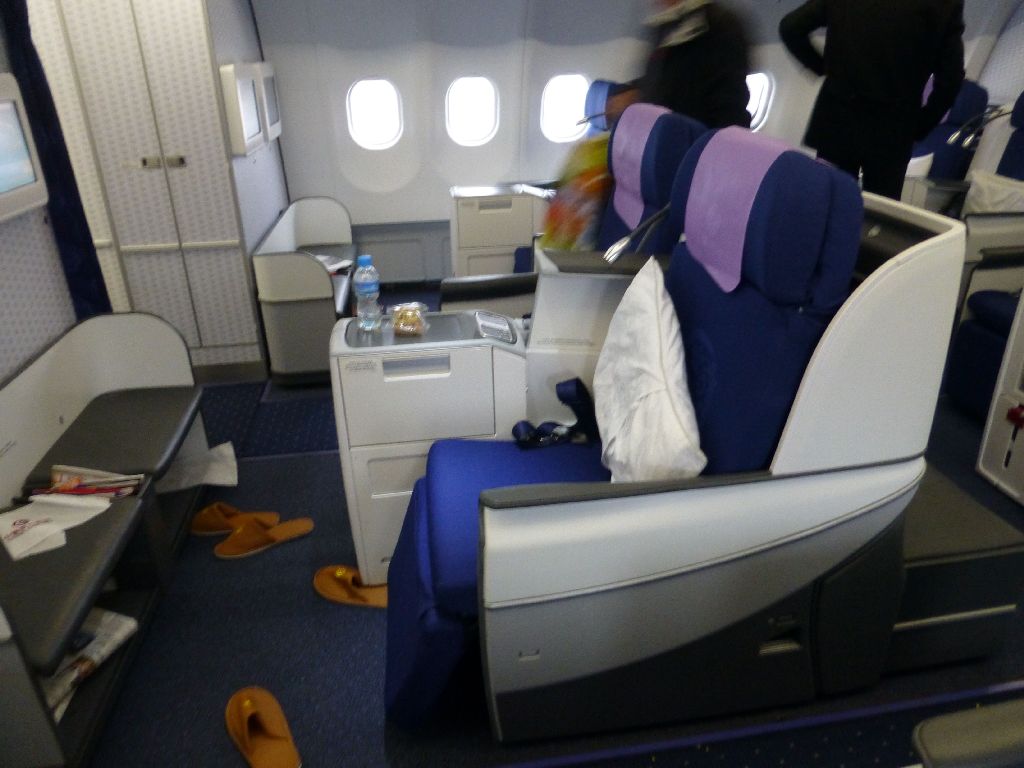
A FA came up to ask if I needed an immigration form (yes I did), and gave me her pen to fill it in. Gave me?, no she came back to recover it. I apologized in Mandarin for having slipped it in my bag. A nice gesture: she came back later to offer me a cheaper one, and inform me by the way that ETA was 7:35, which meant 35' late.

You won't have a video of the landing, because not only was I not at a window, but the cloud ceiling was next to the ground level.
PVG is really plane spotter unfriendly for incoming passengers, and this picture of an MU A330 in Skyteam livery is only here to show that I tried.
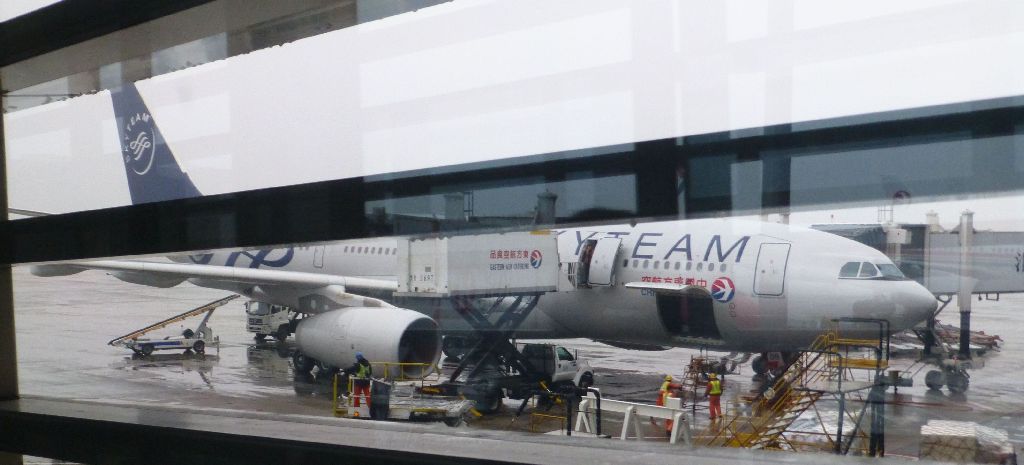
I was resident in Taiwan, but these counters were not for me. China claims sovereignty on Taiwan cannot use the expression Taiwanese citizens, and uses the Taiwanese residents euphemism instead, and mentions travel documents instead of visas which can only be on arrival, since there cannot be a Chinese consulate in Taiwan, which is not supposed to be a foreign country.

In short, this sign means Visa on arrival for Taiwanese citizens, but using that expression would result in a hefty fine in Mainland China.
There was a special line for the citizens of one of 48 countries (including France) which have a visa exemption if they are in transit (for a 72 hour transit maximum, if the next flight is not to the country they flew from). It was a very quick procedure. What was less than quick was the waiting line for the compulsory X ray check of the customs.
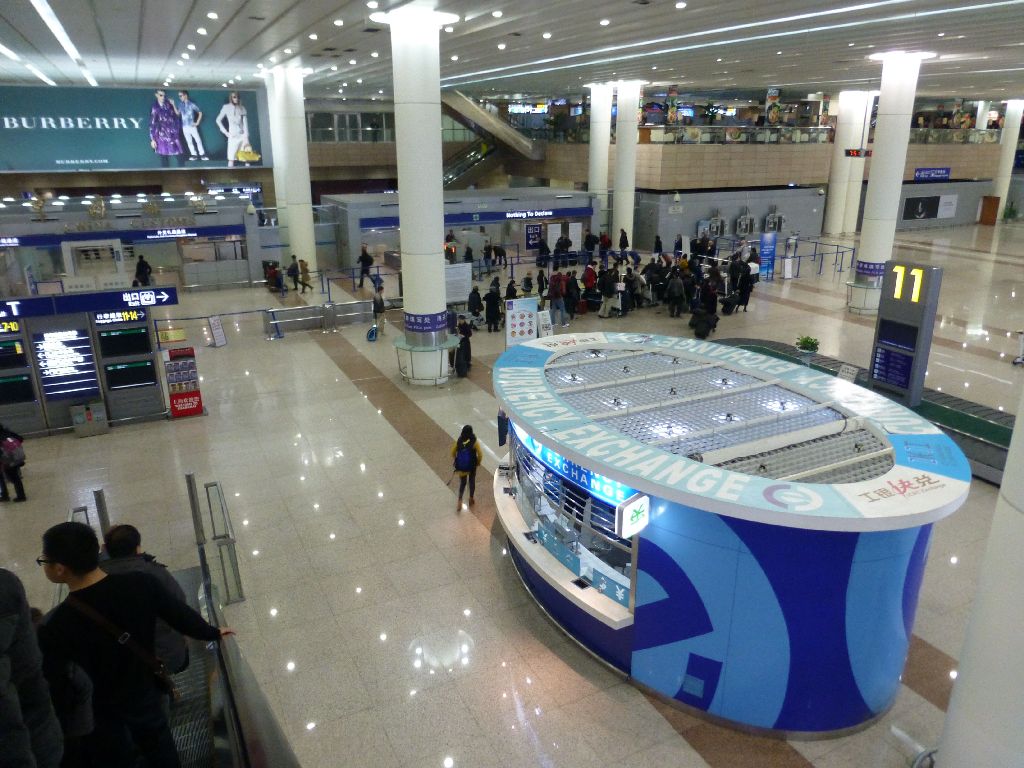
The second machine was eventually started, which suddenly halved the waiting line.
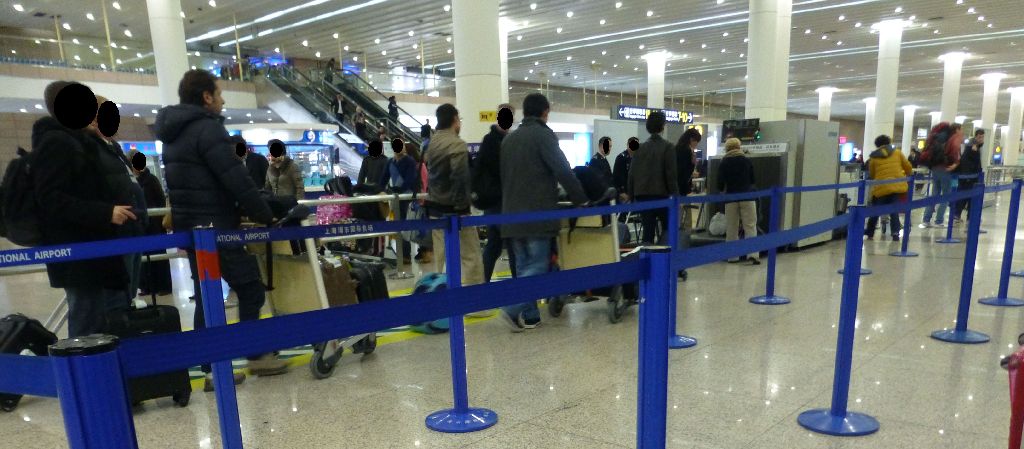
I could not waste time since I wanted to meet a friend in the center of Shanghai: I headed towards the magnetic levitation train via the very long corridor connecting PVG's two parallel terminals.

In Mainland China's train stations, you have access to the platforms at the last moment only: you always must use a waiting room, with archaic steel seats like these in the foreground.
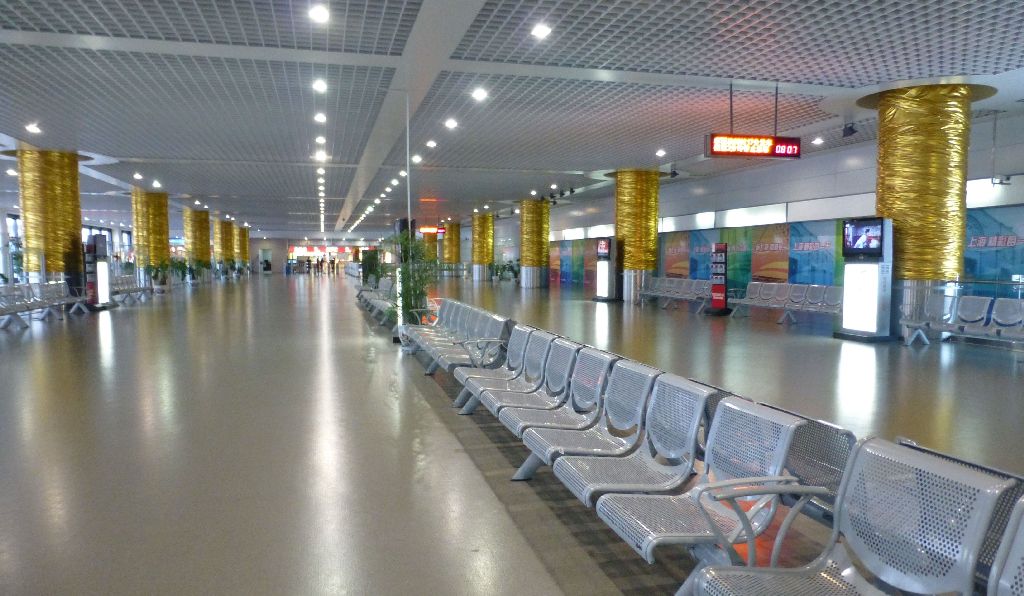
The sign overhead on the right stated that it was 8:07, the next train was at 8:17, but I would have to wait another two minutes until I could reach the platform.
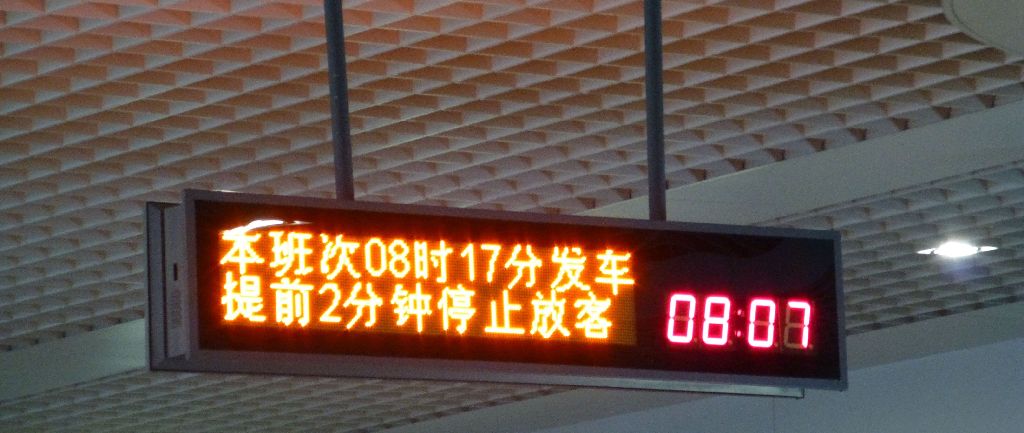
This was the train, a German made Transrapid, not a Japanese Maglev: their levitation and propulsion technologies are different, but the Chinese improperly use the name Maglev in their signage.
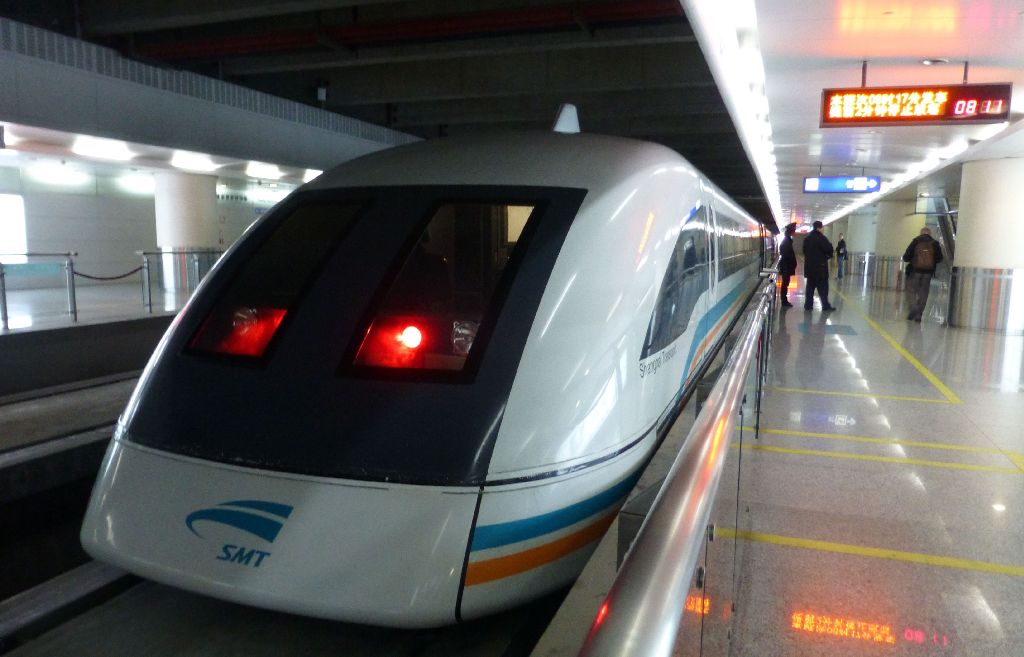
A mixture of modernity and rusticity: there is no platform screen door, but a simple hand operated metal bar which slides into a tubing.
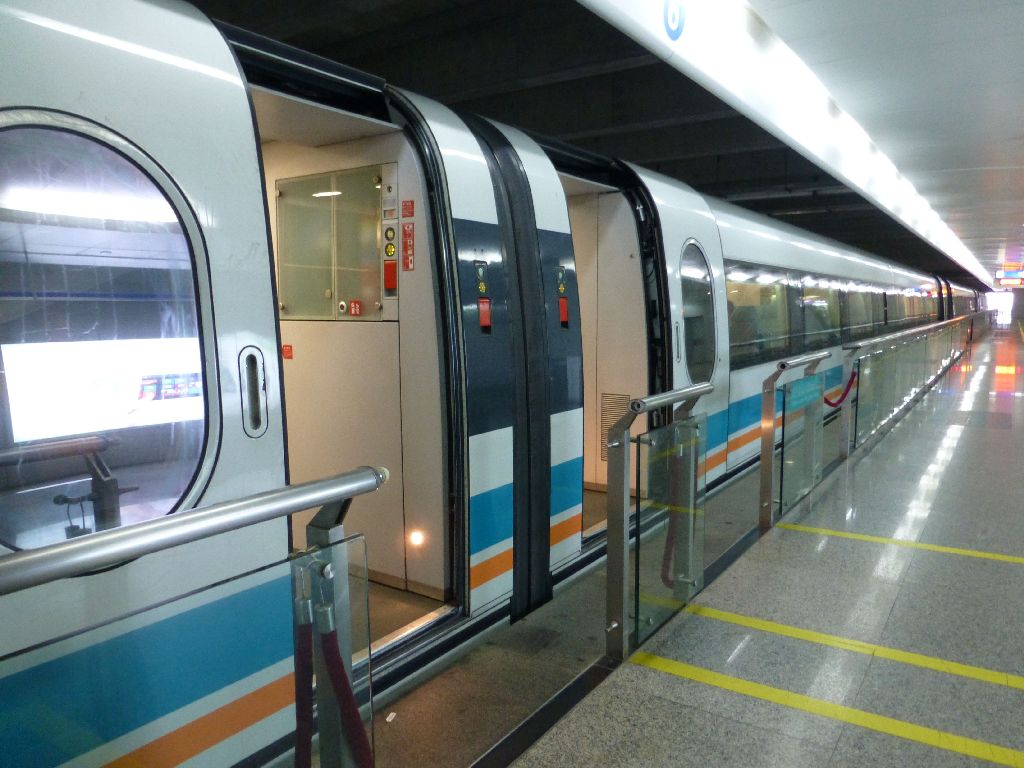
… and the driver, seen here through the glass door in the front, has a cheap supermarket ventilator powered by an extension cord.
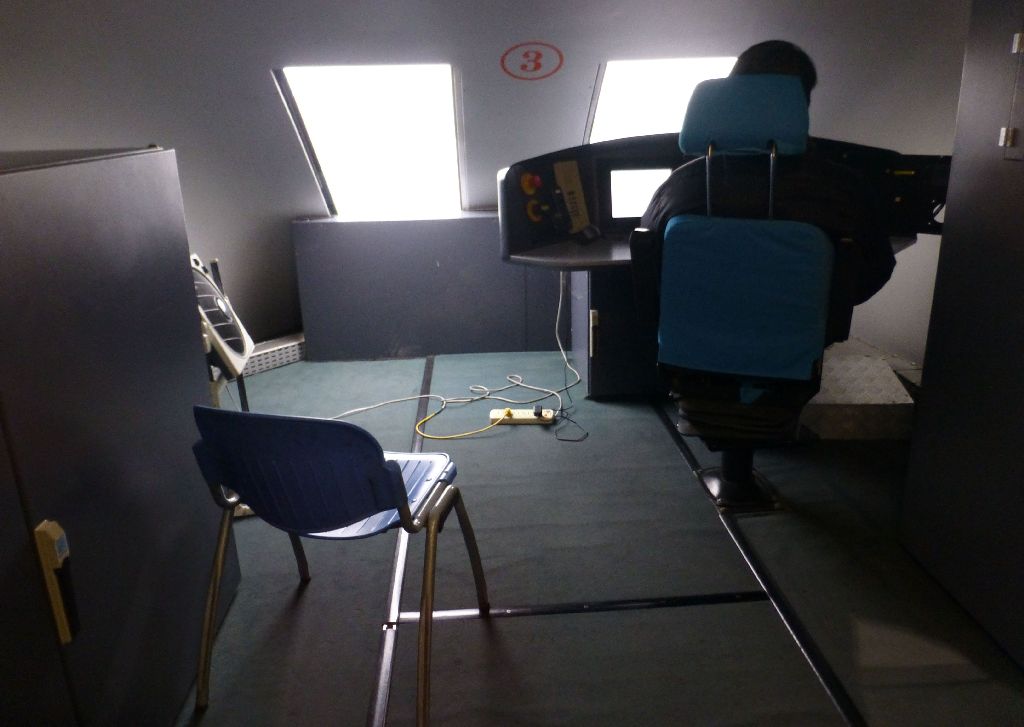
Only during two narrow low demand time periods in mid morning and mid afternoon does the Transrapid reach 431 km/h: it only reaches 301 km/h the rest of the time (this made it 1 km/h faster than France's high speed trains when it started operation). This picture is blurry because the vibrations are much more than those of a conventional high speed train at the same speed.
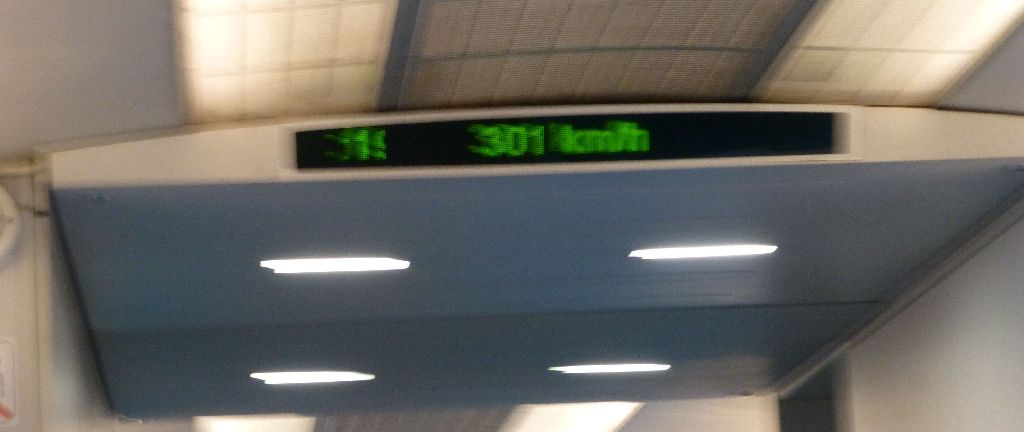
The cabin already showed its age: the seat covers are worn and a floor protection did not hold any more.
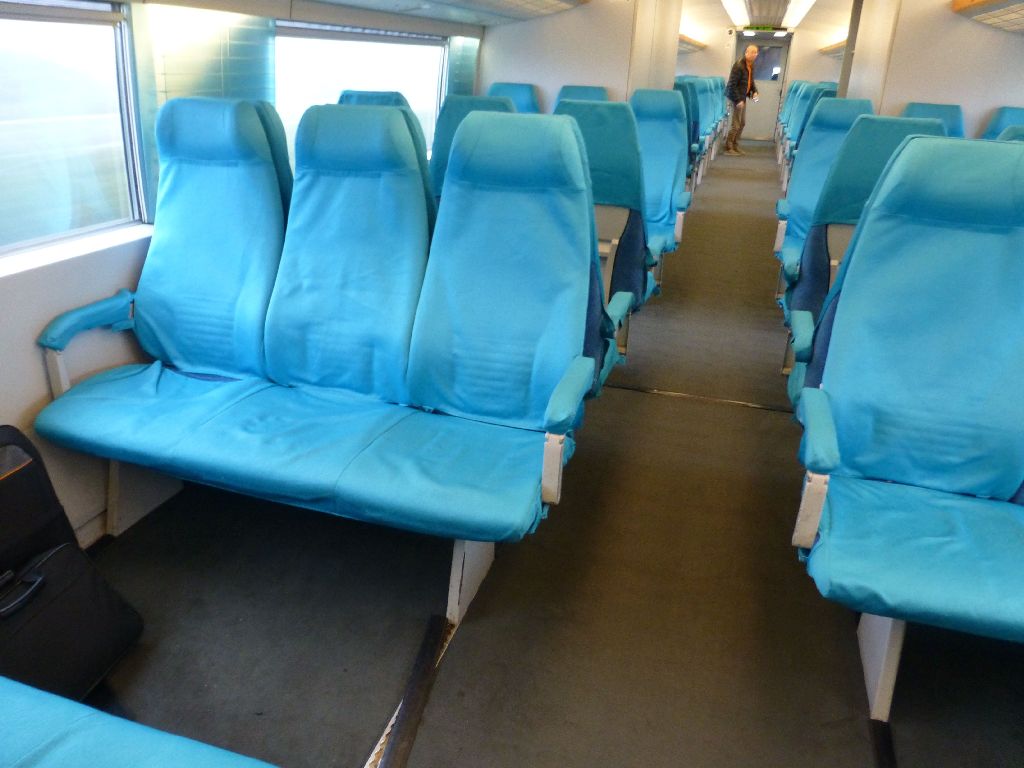
The gain of time by using the Transrapid was not large, because there is only one train every fifteen minutes, and Longyang station, the end of the line, is quite far from the city center: you need to continue on Subway Line 2 which also serves PVG.
The weather in the city center was no better than at the airport, which reduces the tourist bonus.
The park of People's Square can be considered to be the center of Shanghai. How many foreign visitors know that the name of Xizang street, a major thoroughfare along one of its sides, means Tibet Street?

Shanghai's Museum of city planning, well worth visiting.
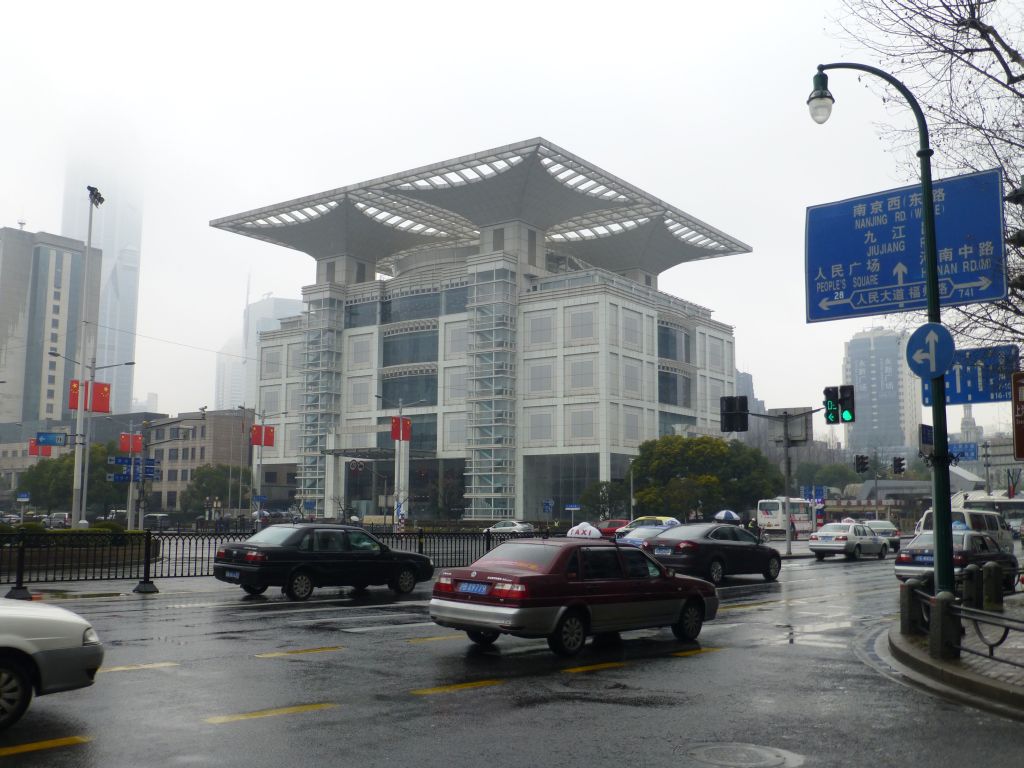
The beige building in the background is the Shanghai Concert Hall, a historical building which was moved in one piece sixty meters away from its original location to make way for an expressway above Yan'an street. The windows of that building were no cleaner than those of many aircraft, but the top of the higher buildings were in the clouds.
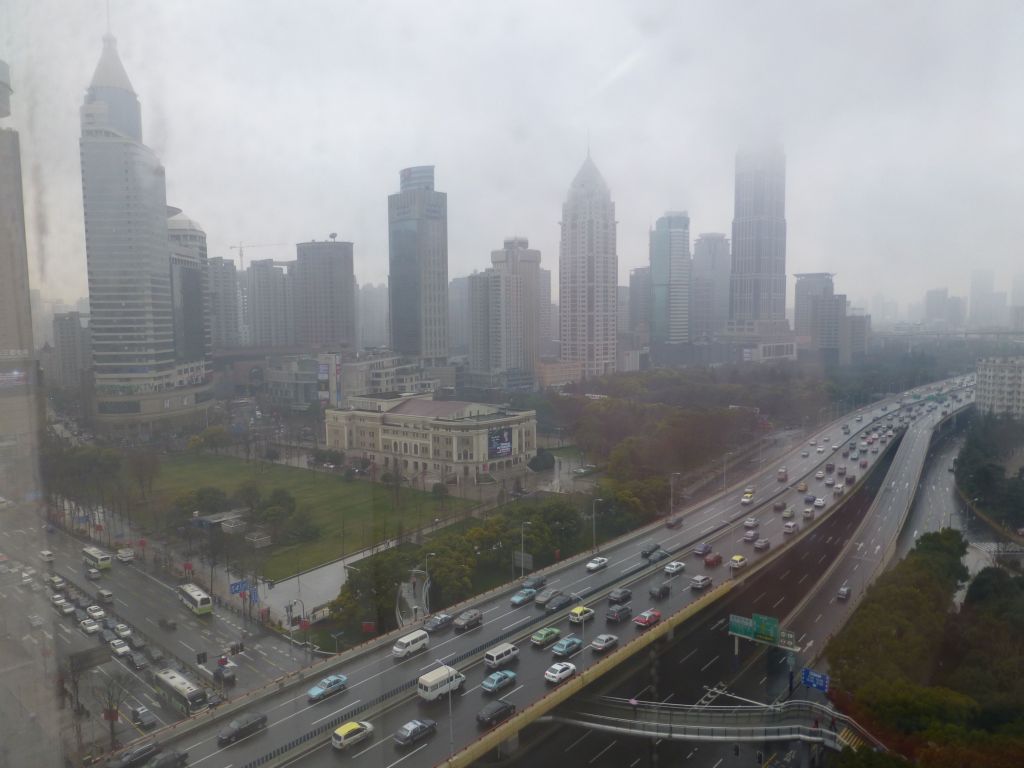
This is the end of this flight report; now is the time to summarize my experience in a seldom reported long haul Chinese flight in economy.
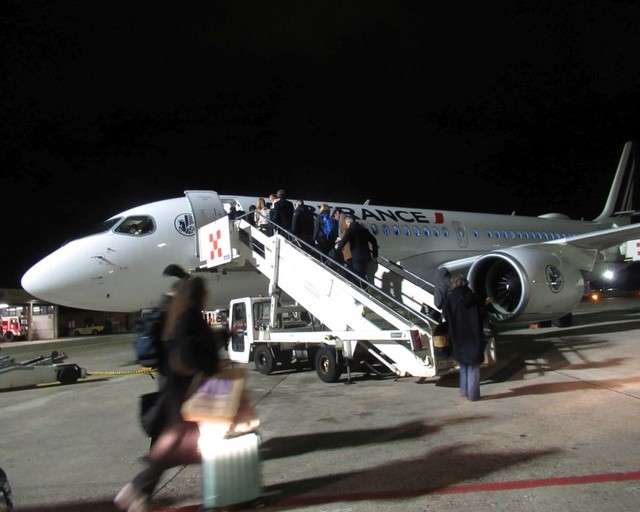
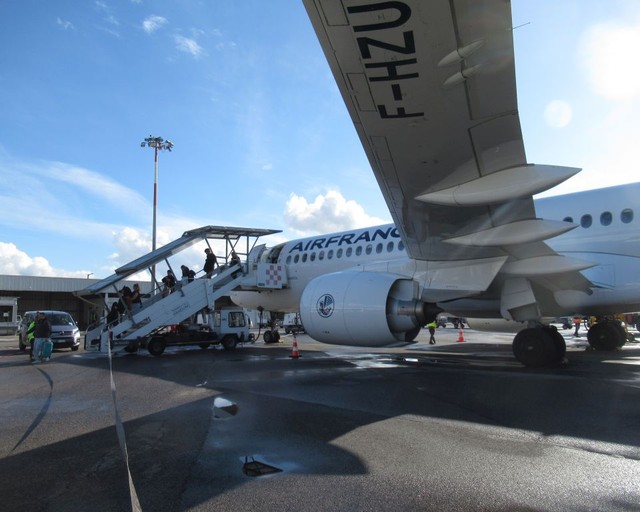


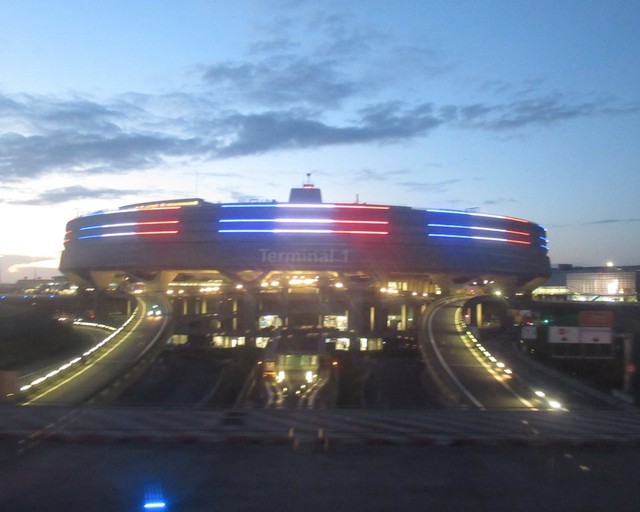
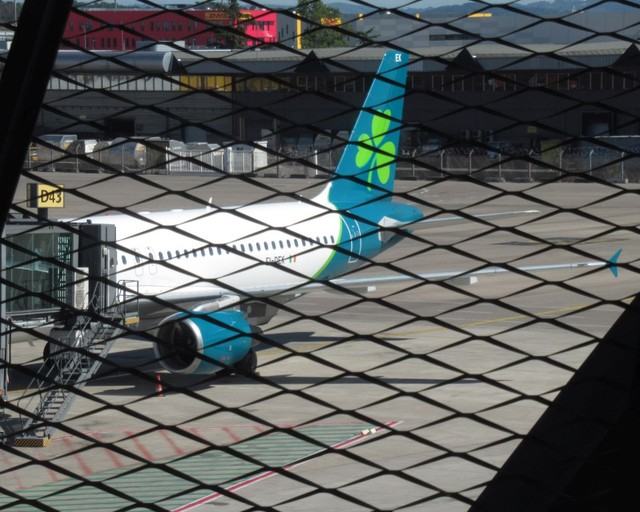

Thanks for this insightful and complete report with the destination bonus. Part of the charm of flying a foreign carrier is to get a taste of the destination beforehand.
As someone with a Chinese background who grew up in Latin America and the US, I can relate with some of the cultural oddities that you encountered in your flight. Drinking hot water is one thing that I can not get used to and I prefer my water at room temperature. As you might know, Chinese hate to consume cold things and always prefer hot temperature food. The reason for this preference might be cultural but also health related. Hot beverages aid digestion and help break down fatty food. It is also believed that when you consume cold drinks or food, that tends to drain you body of energy. Finally, drinking hot water, especially in China is for sanitary reasons in order to kill harmful pathogens. On the other hand, I can't understand the infatuation with ice that Americans have. Growing up in the U.S. I noticed how imperative it was to have a lot of ice with beverages and if you are throwing a party it was essential to get ice for the drinks. One or two cubes at most is sufficient for me.
Personally I would have chosen AF over MU. I love French food and eating chaud froid dishes like terrines and aspics are not a problem.
I believe that one of the purposes of FR is to allow travelers to know what is good, bad or different with each airline in the relevant travel class, flight duration, aircraft, etc. and take educated choices according to one's priorities and constraints. These can of course vary considerably. If this report allows you and others to know why they choose to fly or not fly CA, then it met its target.
Thank you for your elaborate comment !
Au contraire, thanks for your engaging and well presented FR that contains more than just a review of a specific carrier's product. It's always a pleasure to read your reports. I believe you meant MU instead of CA above. ;)
Oops, my mistake; of course I meant MU !